Submitted:
14 March 2024
Posted:
15 March 2024
Read the latest preprint version here
Abstract
Keywords:
1. Introduction
- 1)
- ‘Climate-driven’.
- 2)
- ‘Climate-driven, ecosystem-modified’.
- 3)
- ‘Climate-driven, ecosystem protected’.
- 4)
- ‘Ecosystem-driven’.
- 5)
- ‘Ecosystem-protected’ permafrost.
2. Permafrost Dynamics Modeling: Data and Methods
2.1. Simulation Domain
2.2. Climate Forcing
| Project | Center | Model | Acronym |
|---|---|---|---|
| CMIP5/AR5 | National Center for Atmospheric Research | Community Earth System Model 4 | NCAR-CCSM4 |
| CMIP5/AR5 | NOAA Geophysical Fluid Dynamics Laboratory | Coupled Model 3.0 | GFDL-CM3 |
| CMIP5/AR5 | 5-Model Averaged | Calculated as the mean of the five GCMs* | 5-ModelAverage |
2.3. Permafrost Dynamics Model
- Numerical finite difference solution (method) of heat diffusion;
- At least 100 m in depth vertical computational domain contains 128-256 vertical grid nodes;
- Moss insulation explicitly considered;
- Organic soil insulation explicitly considered;
- Snow insulation explicitly considered;
- Effect of unfrozen water on phase change explicitly considered;
- Thermal conductivity depends on soil moisture, temperature, and unfrozen water content.
2.4. The Ecosystem Approach of Permafrost Modeling
2.5. Data Assimilation and Model Validation
2.5.1. Model Validation
2.6. Sensitivity Analysis
3. Discussion
4. Conclusions
5. Glossary of Permafrost and Related Ground-Ice Terms
- Active layer - the layer of ground that is subject to annual thawing and freezing in areas underlain by permafrost.
- Kurum - A general term for all types of coarse clastic formations on slopes of 2-3 to 40 degrees, moving downslope mainly due to creep.
- Permafrost Table or Top of Permafrost - the upper boundary of permafrost surface.
- Permafrost base - the lower boundary surface of permafrost, above which temperatures are perennially below 0°C (cryotic) and below which temperatures are perennially above 0°C (noncryotic).
- Permafrost thickness - The vertical distance between the permafrost table and the permafrost base.
- Pereletok - is a layer of frozen ground which forms as part of the seasonally frozen ground (in areas free of permafrost or with a lowered permafrost table), re-mains frozen throughout one or several summers, and then thaws.
- Protalus - A pronival rampart, formerly referred to as a protalus rampart, is de-fined as a ridge, series of ridges or ramp of debris formed at the downslope margin of a perennial or semi-permanent snow bed, which is typically located near the base of a steep bedrock slope in a periglacial environment.
- Talik - a layer or body of unfrozen ground occurring in a permafrost area due to a local anomaly in thermal, hydrological, hydrogeological, or hadrochemical conditions.
- Talus. - An outward sloping and accumulated heap or mass of rock fragments of any size or shape (usually coarse and angular) derived from and lying at the base of a cliff or very steep, rocky slope, and formed chiefly by gravitational falling, rolling, or sliding.
- Isolated talik - a layer or body of unfrozen ground surrounded by perennially frozen ground.
- Open talik - a body of unfrozen ground that penetrates the permafrost completely, connecting suprapermafrost and subpermafrost water.
6. Acronyms and Abbreviations
| 5-ModelAvg | Five-Model Average. Composite of five GCMs that best replicate historical climate in Alaska and the Arctic regions (NCAR-CCSM4, GFDL-CM3, GISS-E2-R, IPSL-CM5A-LR, and MRI-CGCM3). |
| AKVWC | Alaska Vegetation and Wetland Composite. |
| ALT | Active Layer Thickness. |
| AR5 | The IPCC Fifth Assessment Report. |
| ASL | Above sea level. |
| APET | Alaskan Permafrost-Ecological Transect. |
| CALM | Circumpolar Active Layer Monitoring. |
| CMIP5 | Coupled Model Intercomparison Project Phase 5. |
| CRREL | Cold Regions Research and Engineering Laboratory. |
| DEM | Digital Elevation Model. |
| DoD | Department of Defense. |
| ERDC | Engineer Research and Development Center. |
| FMA | Five-Model Average. |
| GCM | General Circulation Model. |
| GFDL-CM3 | Geophysical Fluid Dynamics Laboratory Climate System Model. |
| GHG | Greenhouse gases. |
| GI | Geophysical Institute. |
| GIPL | Geophysical Institute Permafrost Lab. |
| GIPL2-MPI | The Geophysical Institute Permafrost Lab Permafrost Dynamics Model of the Second Generation, Parallel-coded using the Message Passing Interface. |
| GIS | Geographic Information System. |
| GTN-P | Global Terrestrial Network for Permafrost. |
| HPC | The high-performance computing. |
| HPCC | High Performance Computing Center. |
| IPCC | Intergovernmental Panel on Climate Change. |
| LTER | Long Term Ecological Research Network. |
| MAAT | Mean annual air temperature. |
| MAGT | Mean annual ground temperature. |
| MMGT | Mean monthly ground temperature. |
| MPI | Message Passing Interface. |
| NWI | National Wetlands Inventory |
| NCAR-CCSM4 | National Center for Atmospheric Research Community Climate System Model. |
| pfTop | Table of Permafrost (top of permafrost). |
| RCSG | Research Computing Systems Group. |
| RCS | Research Computing Systems. |
| RCP | A Representative Concentration Pathway is a greenhouse gas concentration trajectory adopted by the IPCC. Four pathways were used for climate modeling and research for the IPCC Fifth Assessment Report in 2014. |
| RGM | Regional Climate Model. |
| SERDP | Strategic Environmental Research and Development Program. |
| SNAP | Scenarios Network for Alaska and Arctic Planning. |
| UAF | University of Alaska Fairbanks. |
| USARAK | United States Army Alaska. |
| USGS | United States Geological Service. |
| VWC | Volumetric Vater Content. |
Appendix A. The GIPL2-MPI Physical Model
A1. Mathematical Formulation
A2. Numerical Implementation
Appendix B. Sensitivity Analysis: Model Sensitivity to Surface Conditions and Organic Matter
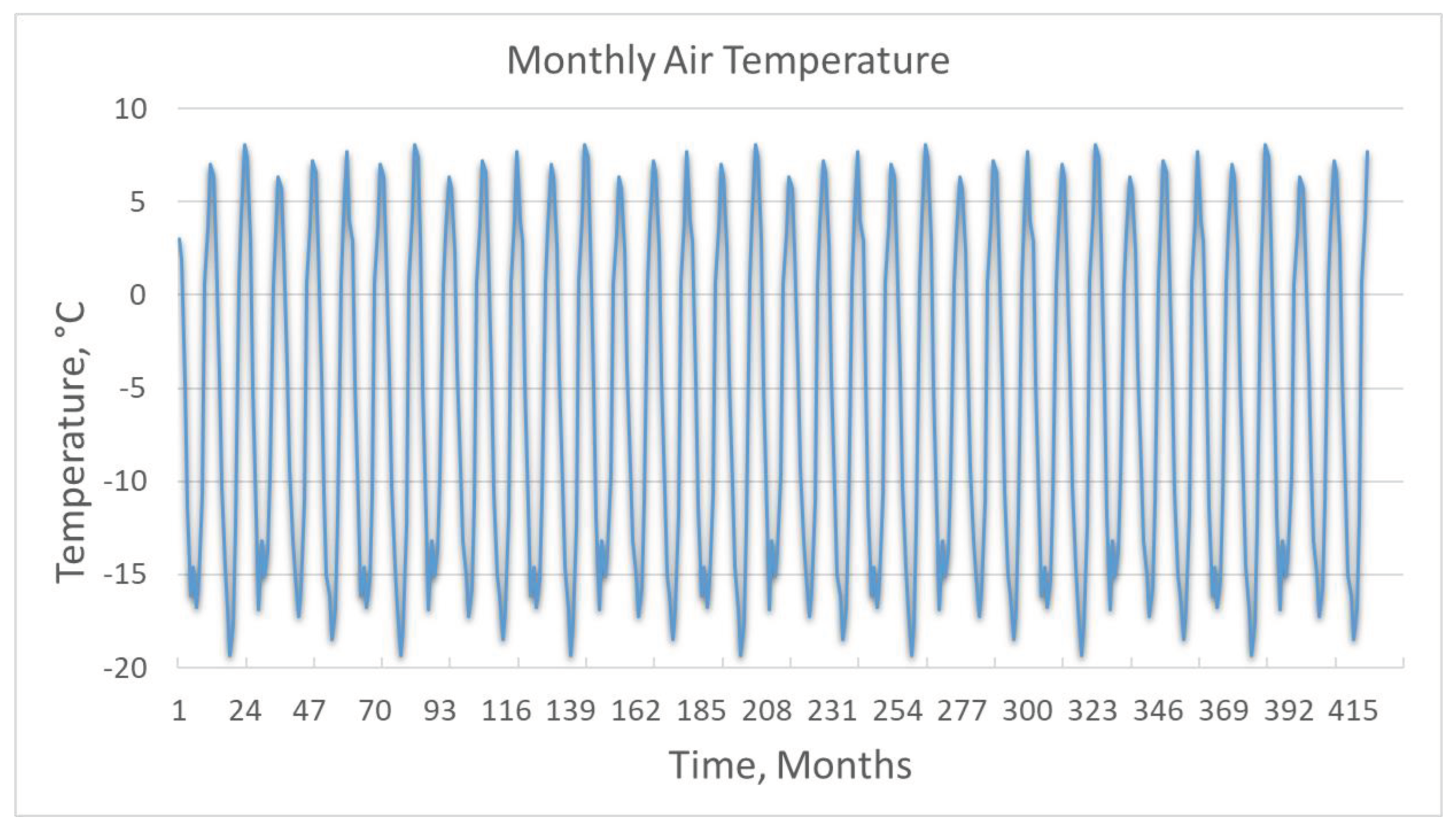
| Bottom of the Soil Layer’s, m | VWC | Cond th | Cond fr | Cap th | Cap fr | Thickness (m) and description of the soil layer | |
|---|---|---|---|---|---|---|---|
| 0.12 | 0.571 | 0.321 | 0.943 | 1.83d6 | 1.32d6 | 0.12 | Moss |
| 0.22 | 0.542 | 0.442 | 0.987 | 1.95d6 | 1.46d6 | 0.1 | Peat 1, fibrous, remains of grass root |
| 0.68 | 0.514 | 0.612 | 1.213 | 2.85d6 | 2.32d6 | 0.46 | Peat 2, amorphous |
| 2.68 | 0.456 | 1.023 | 1.354 | 2.95d6 | 2.42d6 | 2.0 | Mineral soil 1, silt, fine-grained soil |
| 8.8 | 0.398 | 1.232 | 1.567 | 3.17d6 | 2.73d6 | 6.12 | Mineral soil 2, silt, fine-grained sand |
| 48.5 | 0.351 | 1.324 | 1.621 | 2.89d6 | 2.38d6 | 39.7 | Mineral soil 3, clay, silt, sand |
| 52.0 | 0.323 | 1.654 | 1.978 | 3.26d6 | 2.75d6 | 3.5 | Gravel, coarse sand, coarse debris |
| 100.0 | 0.075 | 3.204 | 3.298 | 3.53d6 | 2.93d6 | 48.0 | Bedrock 5% cracks |
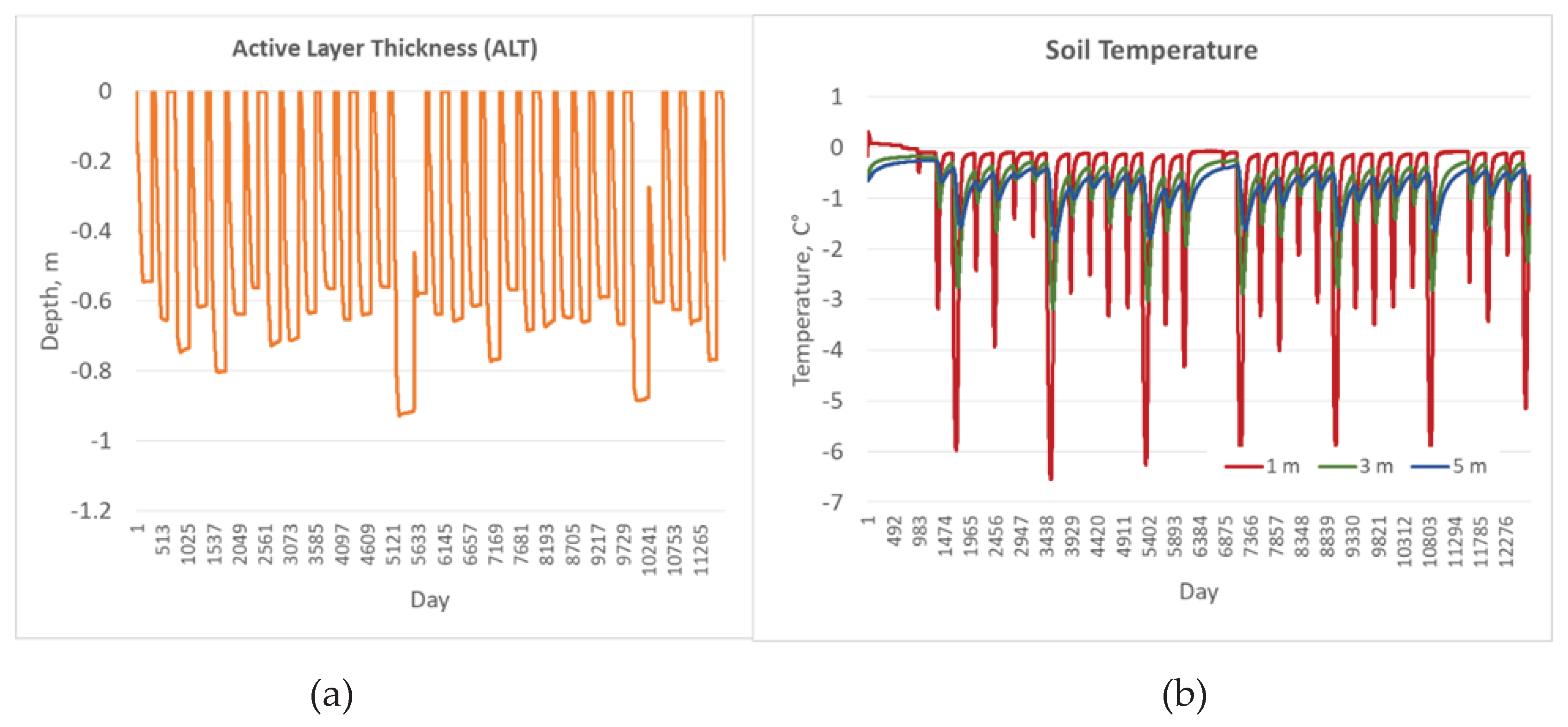
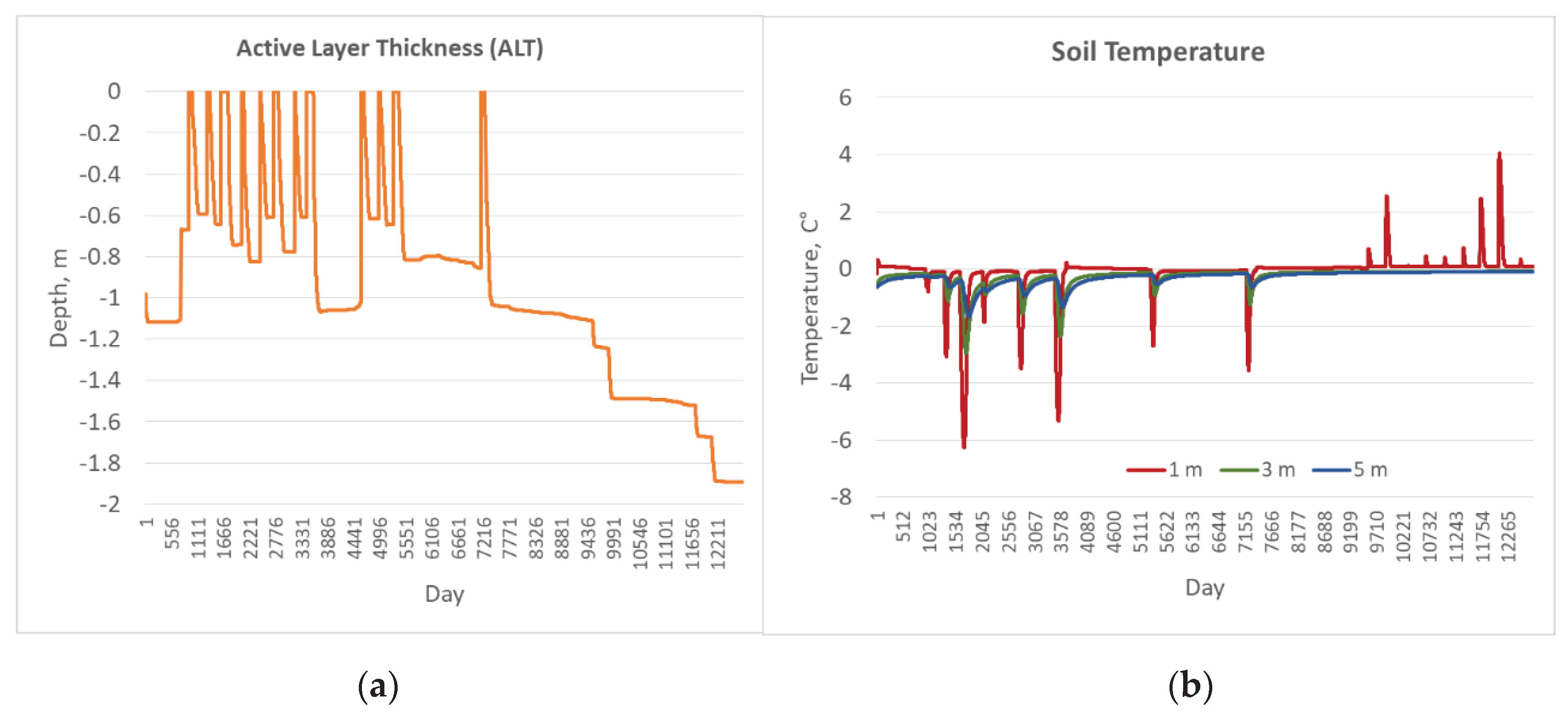
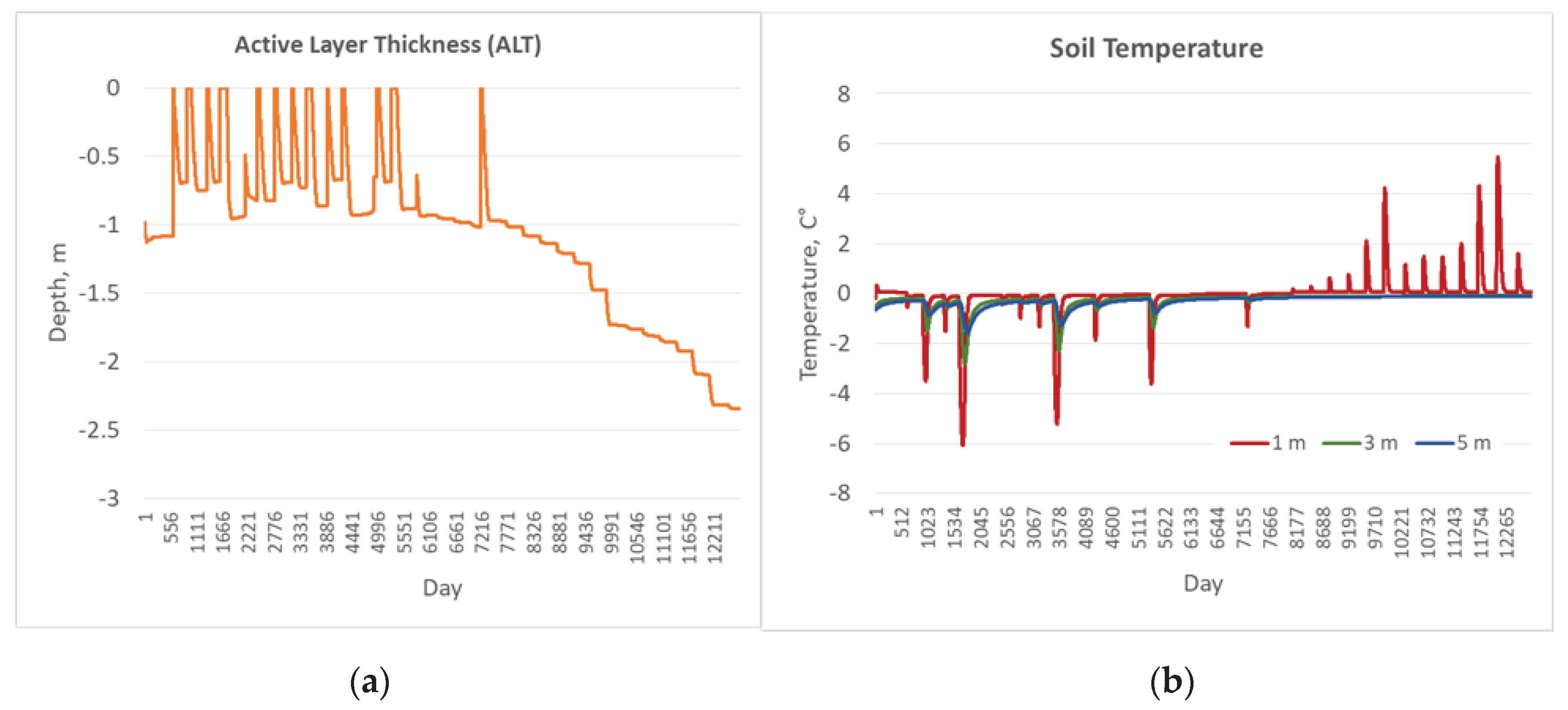
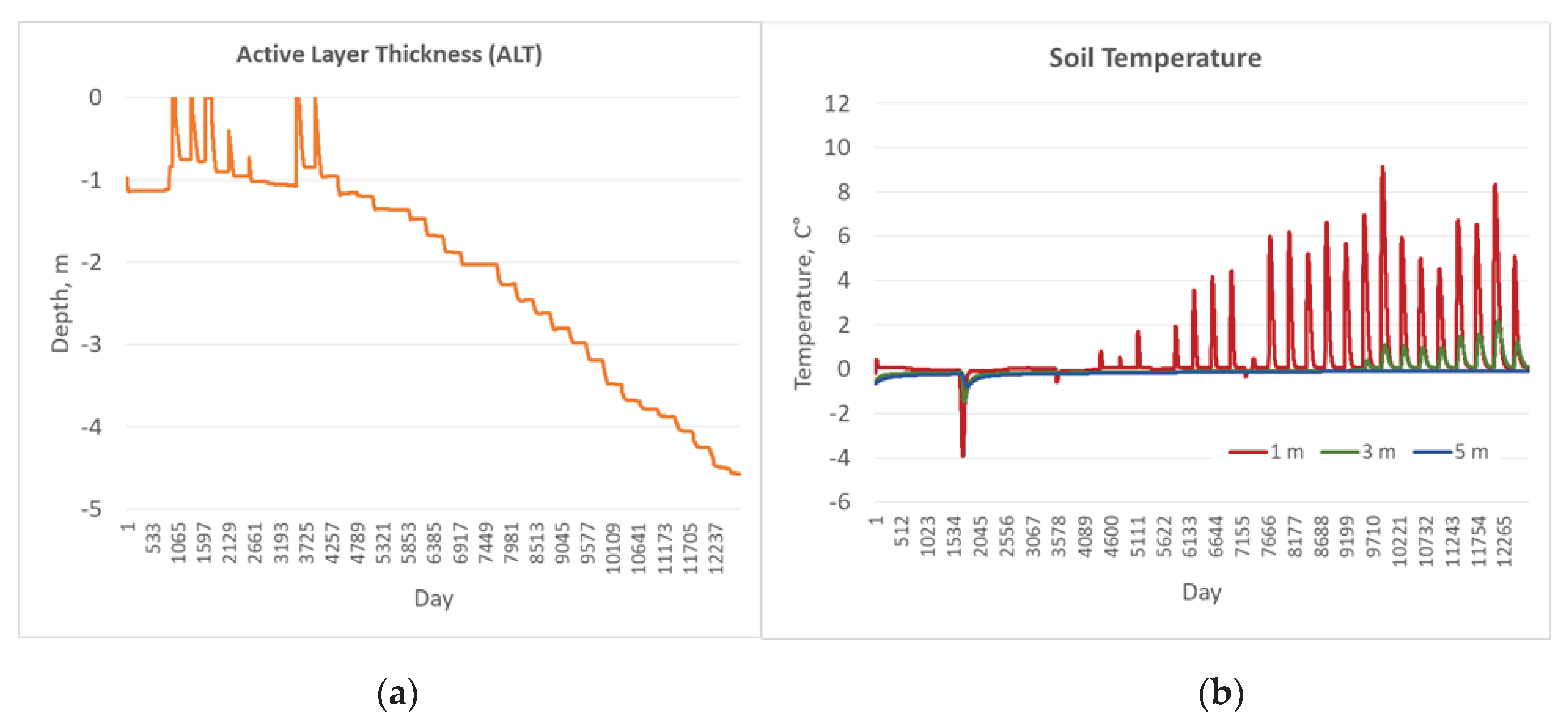
Appendix C. Result of the GIPL2-MPI Spatial and Temporal Permafrost Dynamics Modeling During 2021-2120: GeoTIF Digital Maps
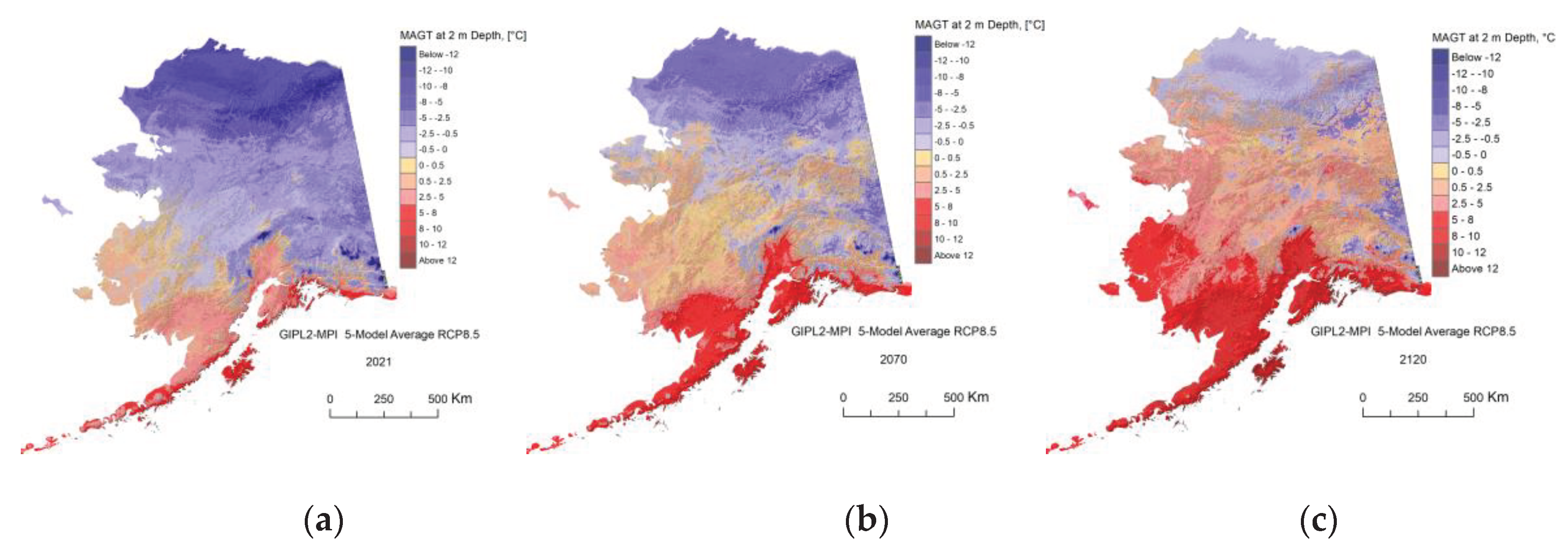
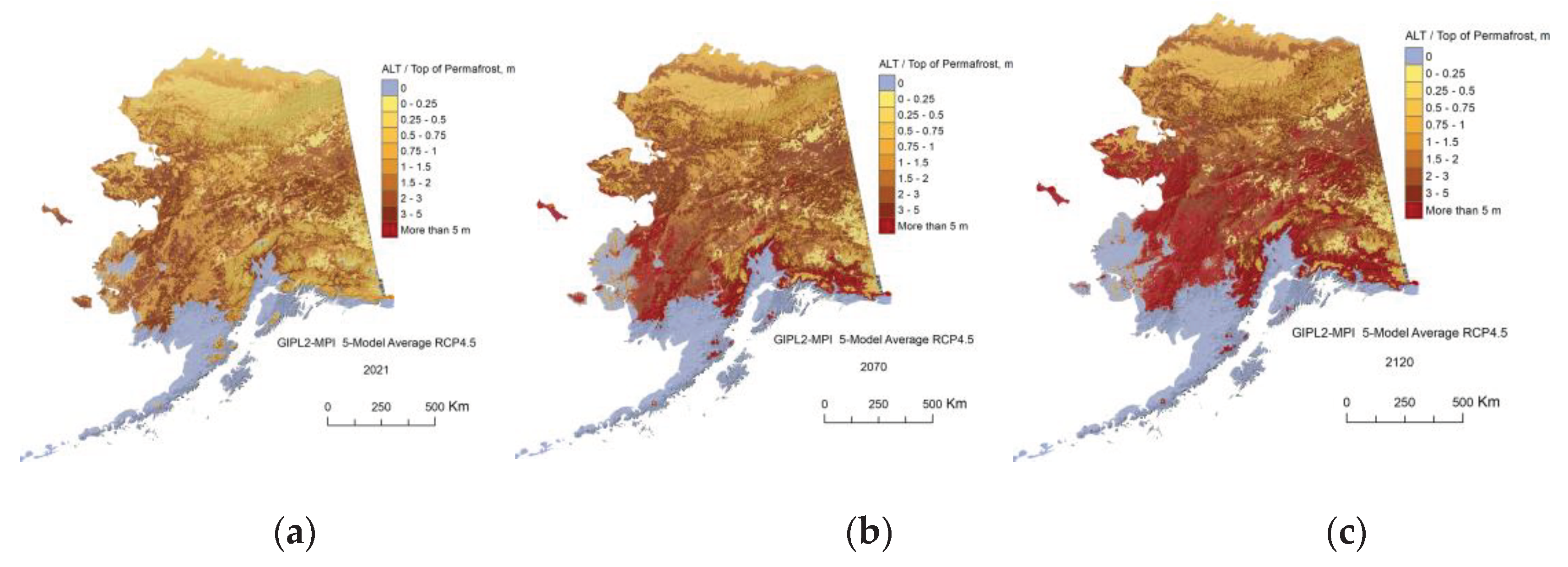
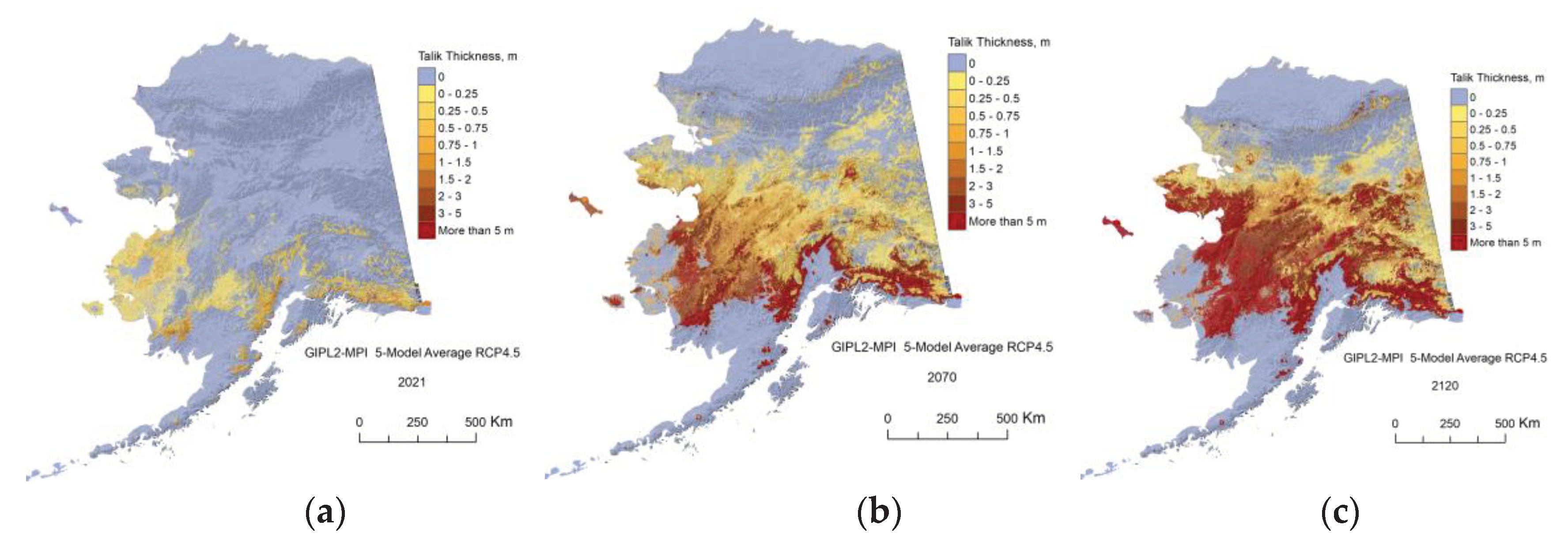
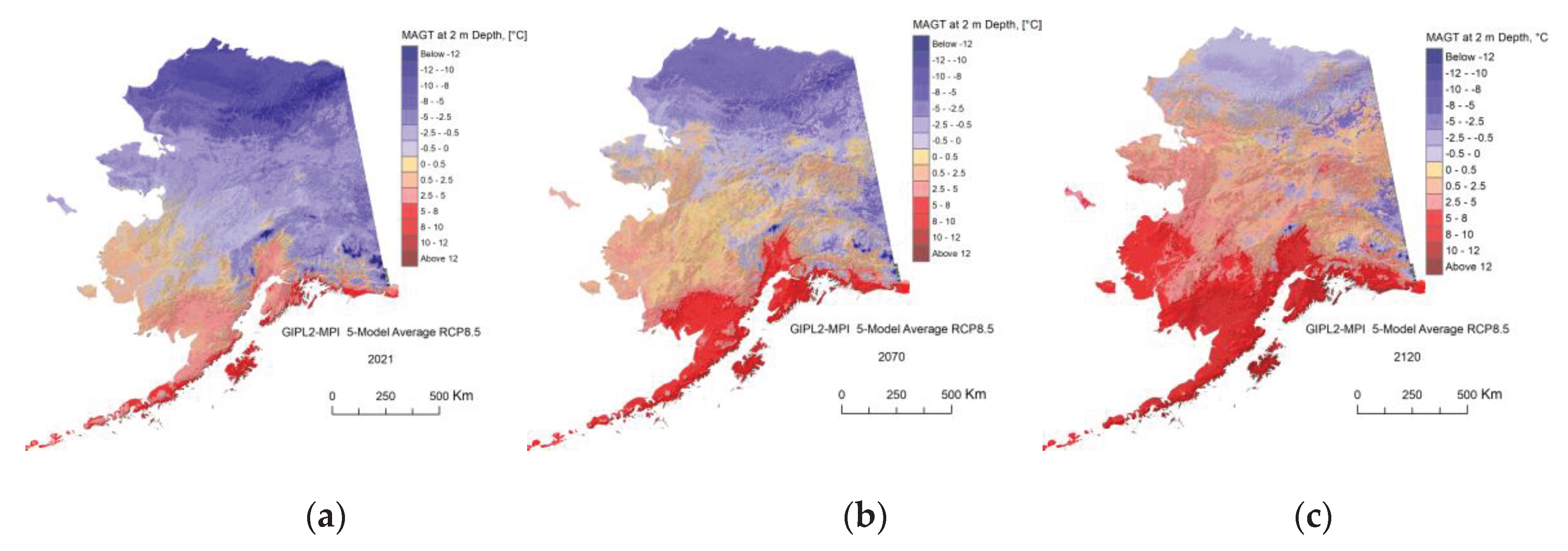
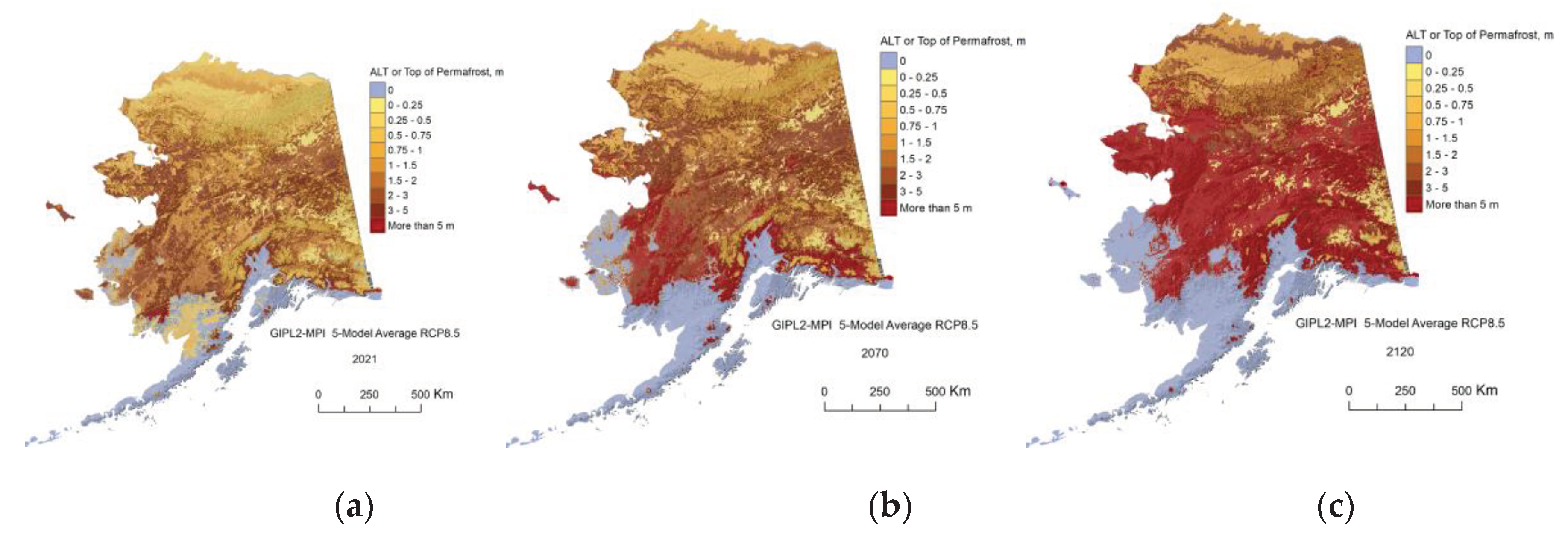
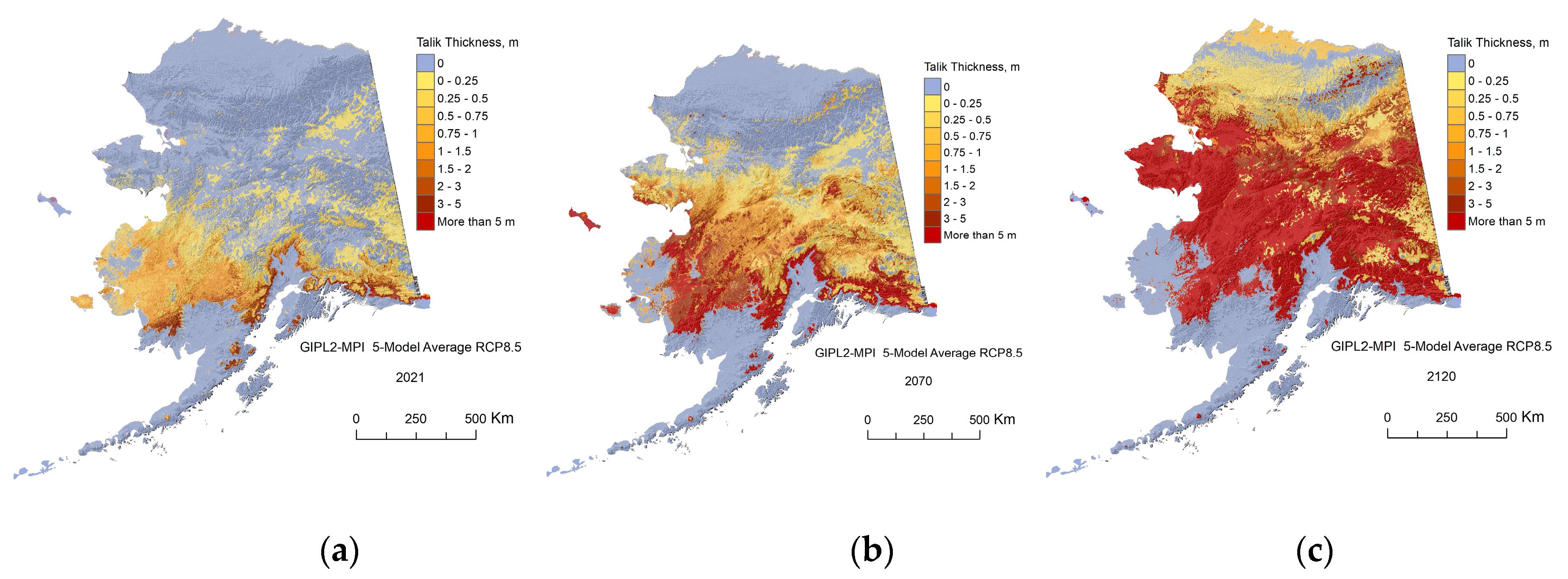
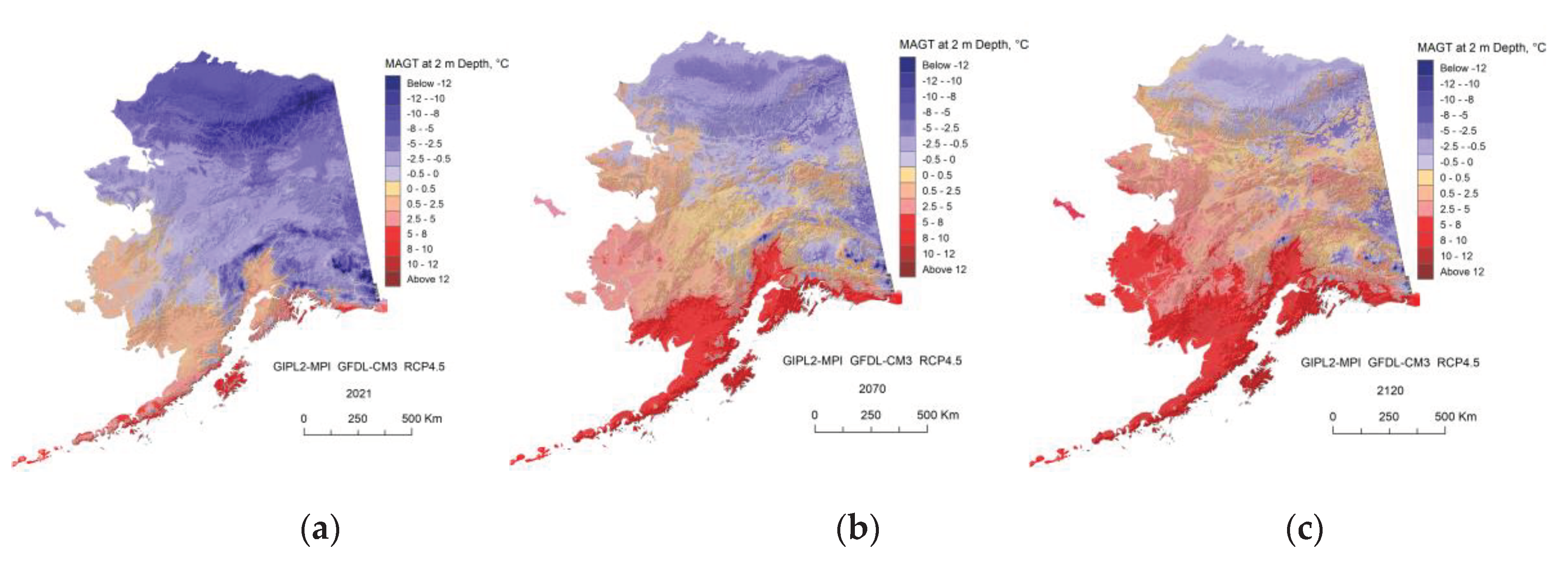

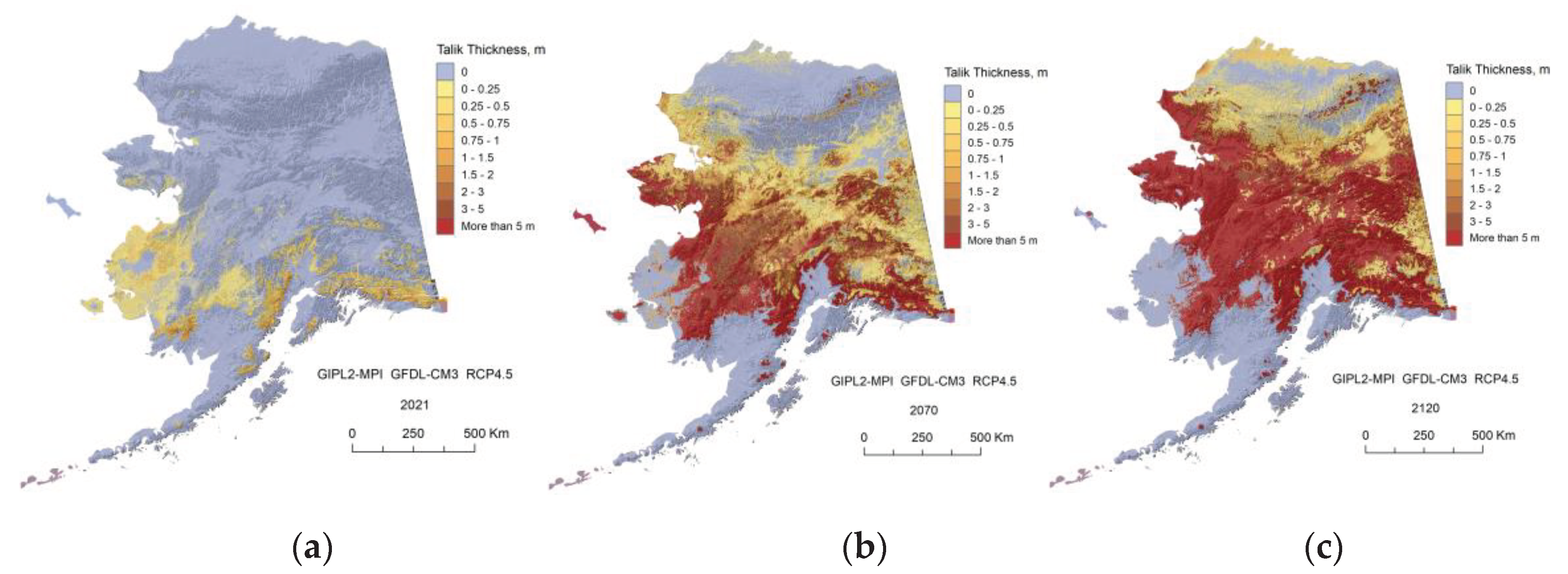
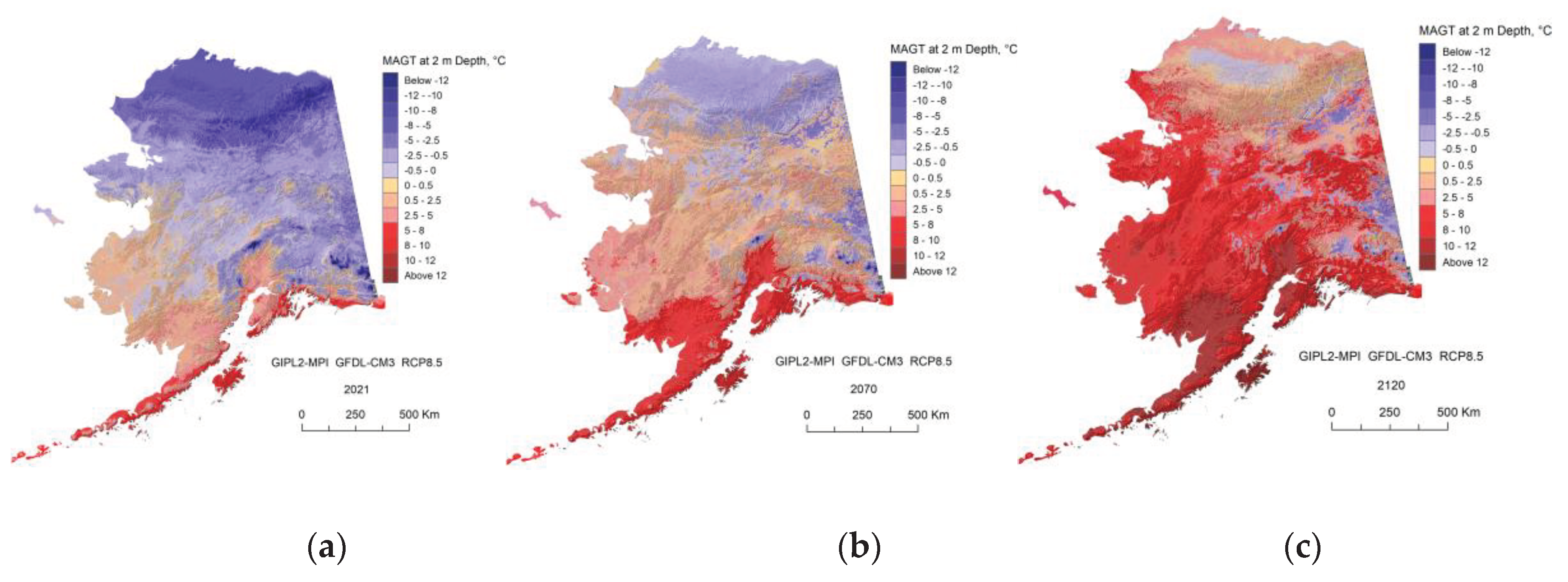
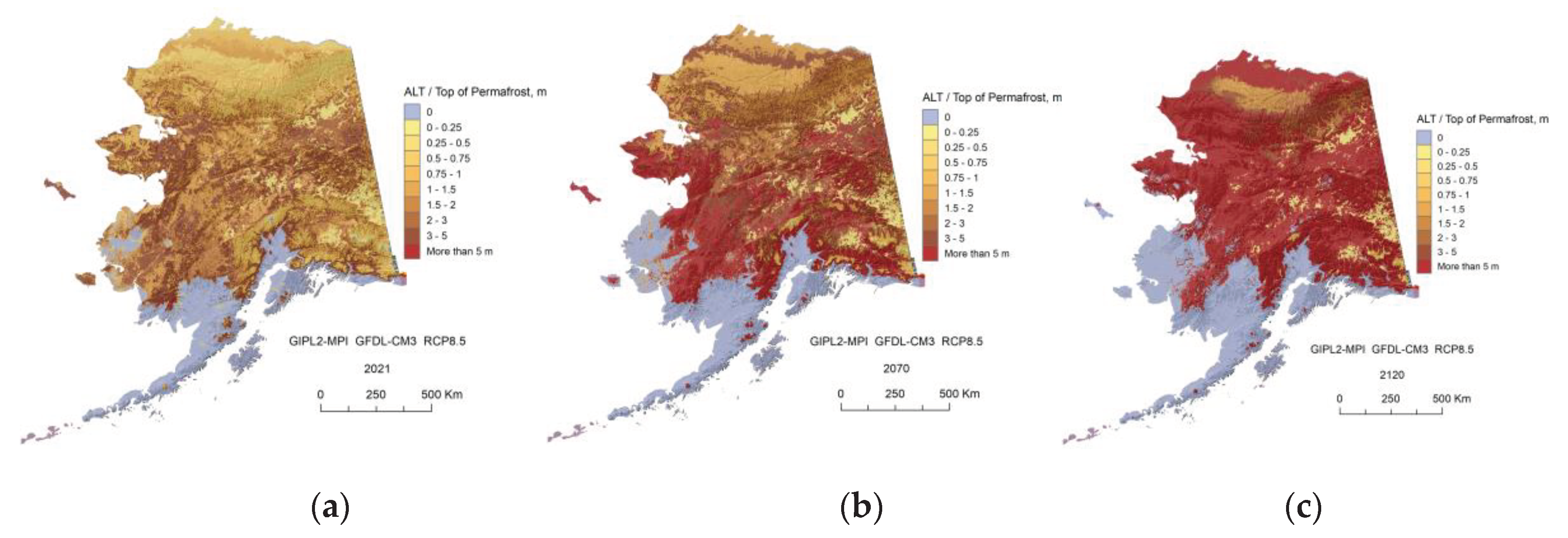
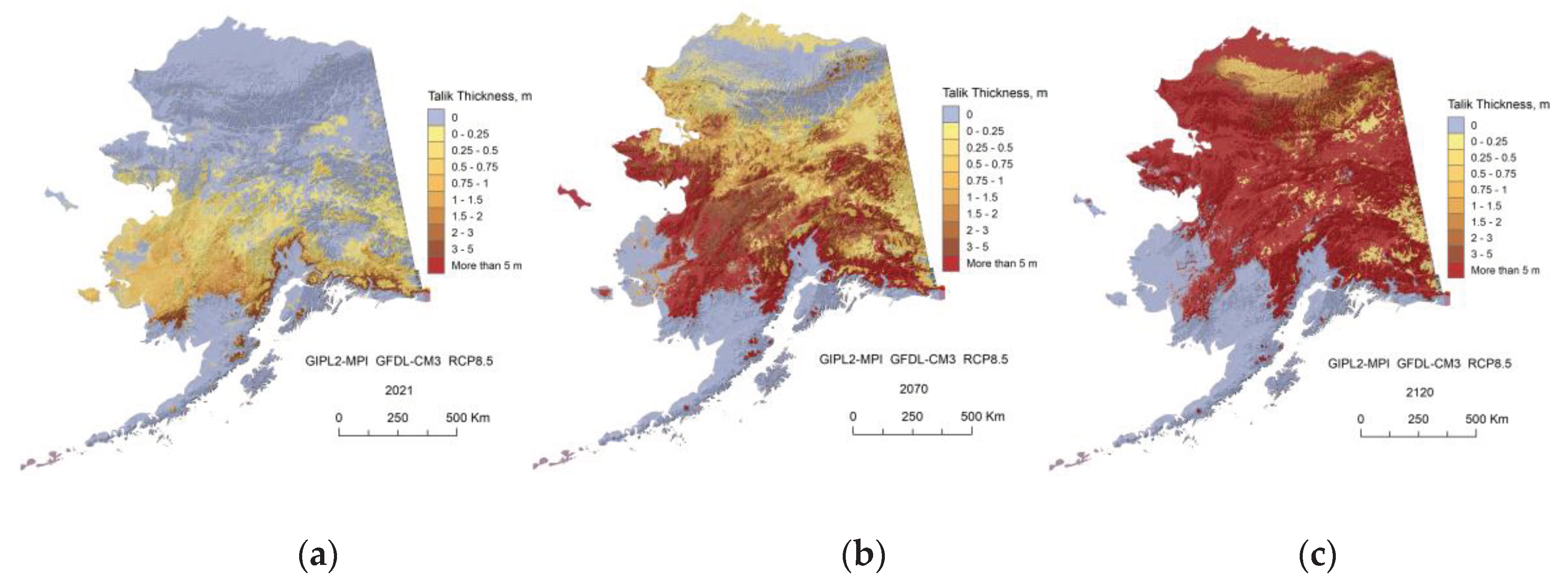
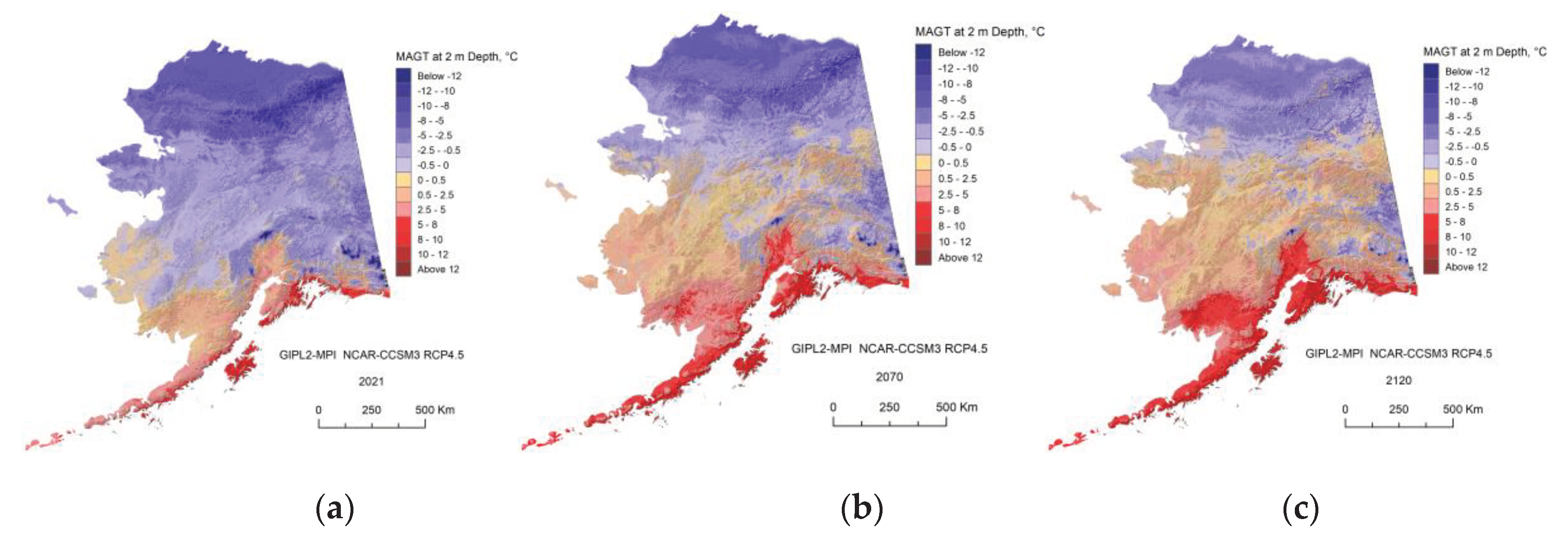
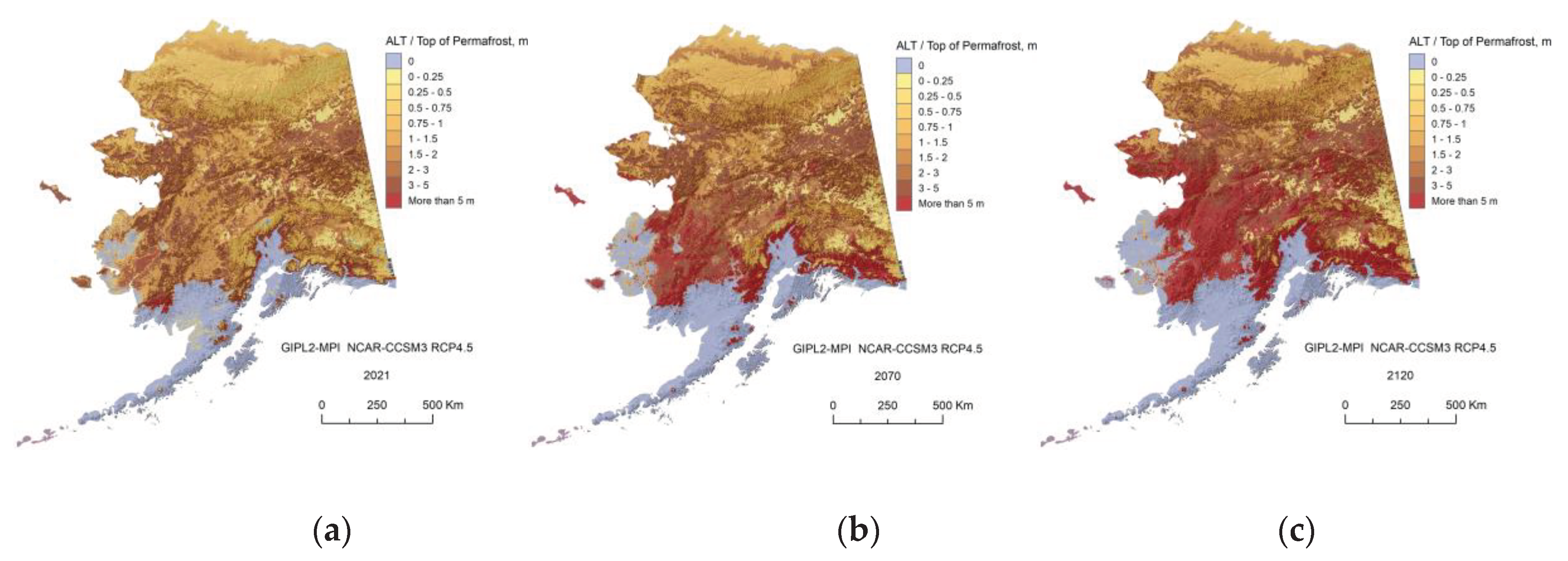
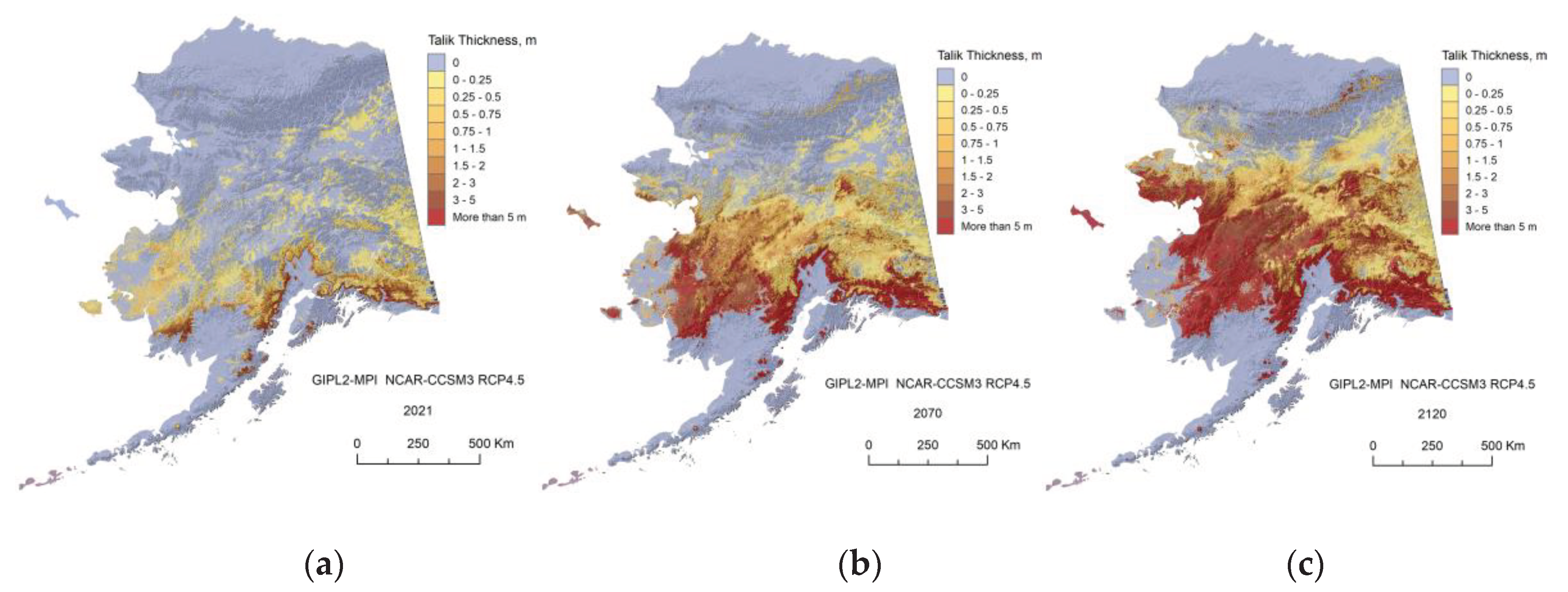
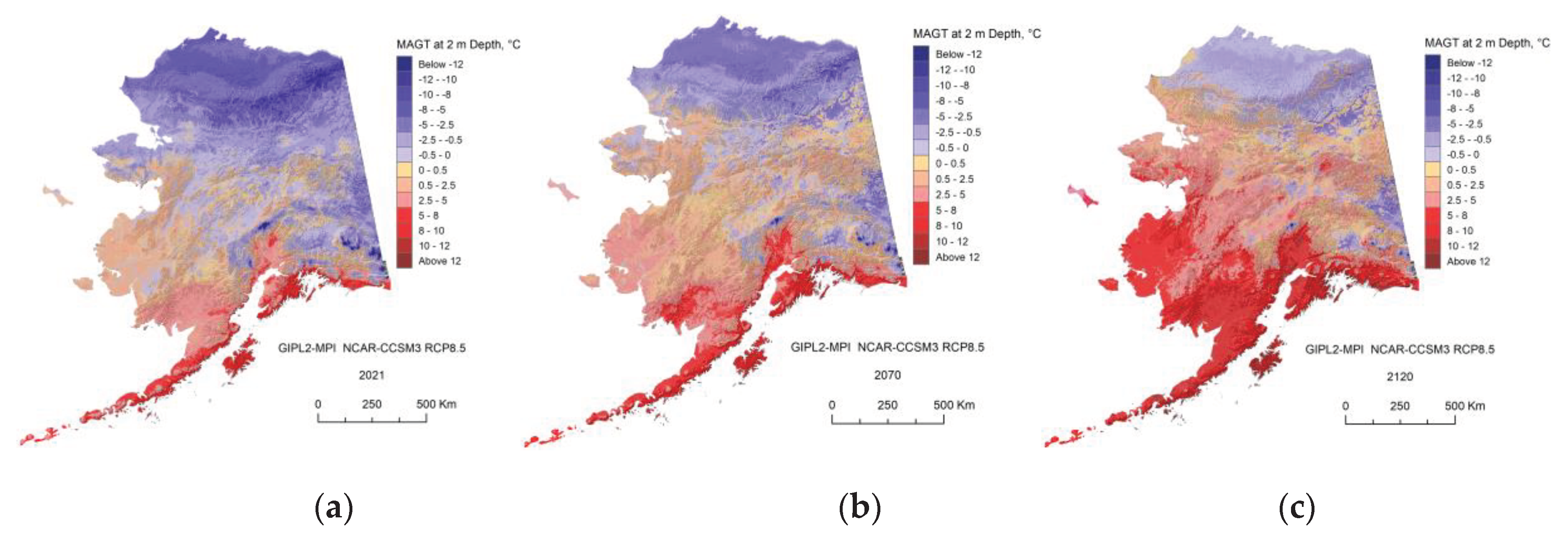
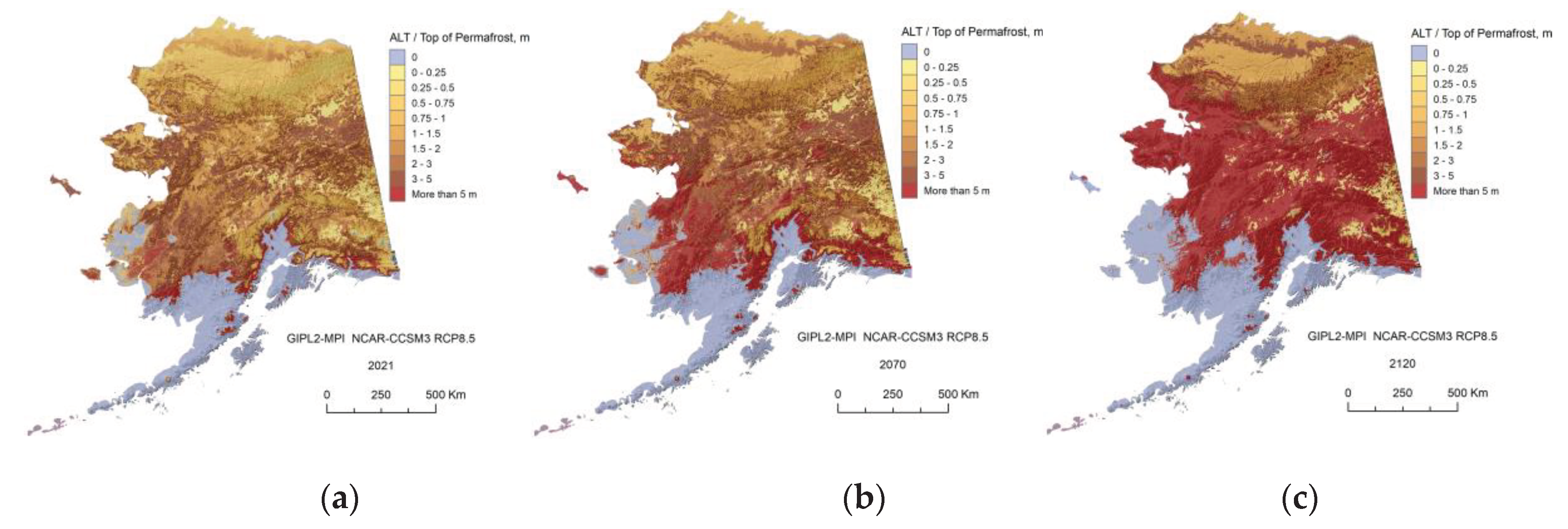
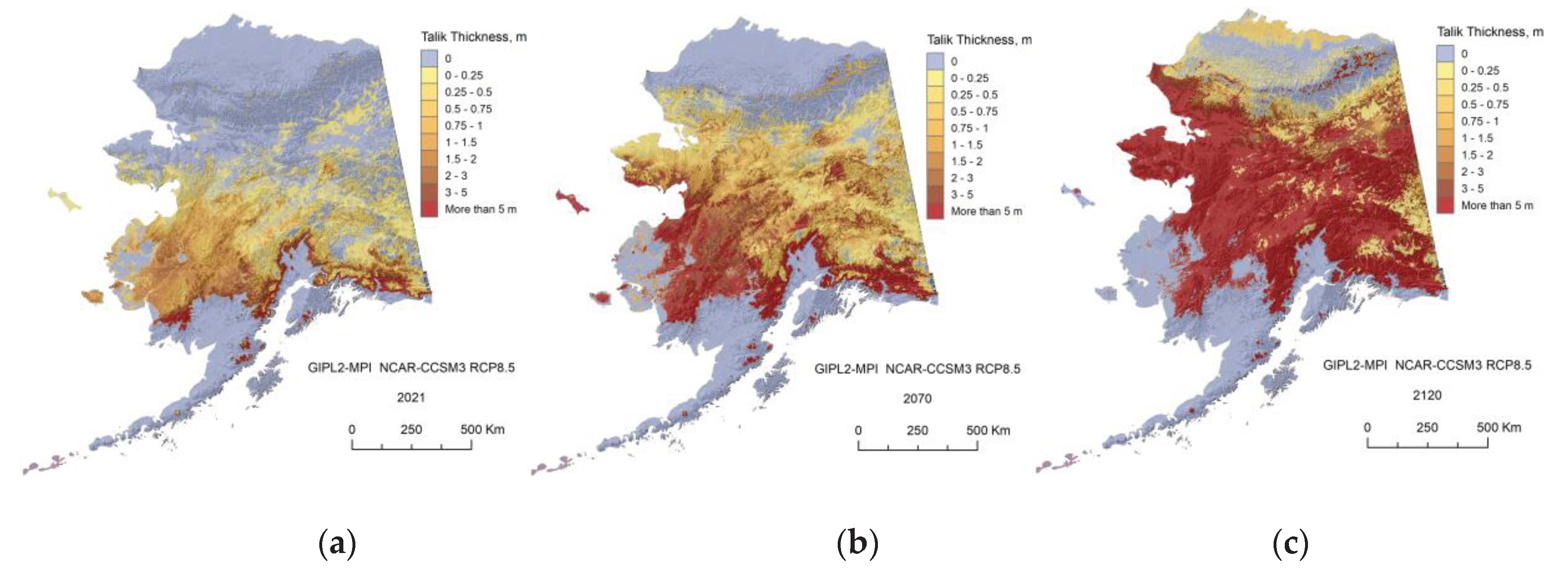
References
- Biskaborn, B.K.; Smith, S.L.; Noetzli, J.; Matthes, H.; Vieira, G.; Streletskiy, D.A.; Schoeneich, P.; Romanovsky, V.E.; Lewkowicz, A.G.; Abramov, A.; Allard, M. Permafrost is warming at a global scale. Nat. Commun. 2019, 10, 264. [Google Scholar] [CrossRef]
- Romanovsky, V.; Marchenko, S.S.; Kholodov, A.L.; Oberman, N.G.; Drozdov, D.S.; Malkova, G.V.; Vasiliev, A.A.; Sergeev, D.O.; Zheleznyak, M.N. Thermal State and Fate of Permafrost in Russia: First Results of IPY (Plenary Paper). In: Proc 9th Int Conf on Permafrost (Kane DL & Hinkel KM, Eds), Univ AK Fairbanks, June 29 - July 3, 2008, Vol. II: 1511-1518.
- Romanovsky, V.E.; Smith, S.L.; Christiansen, H.H. Permafrost thermal state in the polar northern hemisphere during the International Polar Year 2007-2009: a synthesis. Permafrost and Periglacial Processes 2010, 21, 106–116. [Google Scholar] [CrossRef]
- Smith, S.L.; Romanovsky, V.E.; Lewkowicz, A.G.; Burn, C.R.; Allard, M.; Clow, G.D.; Yoshikawa, K.; Thoop, J. . Thermal state of permafrost in North America - A contribution to the International Polar Year. Permafrost and Periglacial Processes 2010, 21, 117–135. [Google Scholar] [CrossRef]
- Osterkamp, T.E. Establishing long-term permafrost observatories for active layer and permafrost investigations in Alaska: 1977–2002. Permafrost Periglacial Processes 2003, 14, 331–342. [Google Scholar] [CrossRef]
- Osterkamp, T.E. The Recent Warming of Permafrost in Alaska. Global Planet Change 2005, 49, 187–202. [Google Scholar] [CrossRef]
- Osterkamp, T.E.; Gosink, J.P.; Kawasaki, K. Measurements of permafrost temperatures to evaluate the consequences of recent climate warming; final report, Contract 84 NX 203 F 233181; Alaska Dept. of Transp. Public Facil.: Fairbanks, Alaska, 1987. [Google Scholar]
- Osterkamp, T.E.; Gosink, J.P.; Kawasaki, K. Permafrost temperature measurements in an Alaskan transect: Preliminary results; Spec. Rep. 1984, 85-5; U.S. Army Cold Reg. Res. and Eng. Lab.: Hanover, NH.
- Osterkamp, T.E. Thermal state of permafrost in Alaska during the fourth quarter of the twentieth century. In Proceedings of the Ninth International Conference on Permafrost, Fairbanks, Alaska, 29 June–3 July 2008; Volume 2, pp. 1333–1338. [Google Scholar]
- ACIA. Arctic Climate Impact Assessment. ACIA Overview report. 2005. Cambridge University Press. 1020pp.
- Boer, G.J.; Flato, G.M.; Reader, M.C.; Ramsden, D. A transient climate change simulation with historical and projected greenhouse gas and aerosol forcing: experimental design and comparison with the instrumental record for the 20th century. Climate Dynamics 2000, 16, 405–425. [Google Scholar] [CrossRef]
- IPCC, 2013: Climate Change 2013: The Physical Science Basis. Contribution of Working Group I to the Fifth Assessment Report of the Intergovernmental Panel on Climate Change [Stocker, T.F., D. Qin, G.-K. Plattner, M. Tignor, S.K. Allen, J. Boschung, A. Nauels, Y. Xia, V. Bex and P.M. Midgley (eds.)]. Cambridge University Press, Cambridge, United Kingdom and New York, NY, USA, 1535 pp.
- IPCC, 2014: Climate Change 2014: Synthesis Report. Contribution of Working Groups I, II and III to the Fifth Assessment Report of the Intergovernmental Panel on Climate Change [Core Writing Team, R.K. Pachauri and L.A. Meyer (eds.)]. IPCC, Geneva, Switzerland, 151 pp.
- IPCC, 2022: Climate Change 2022: Mitigation of Climate Change. Contribution of Working Group III to the Sixth Assessment Report of the Intergovernmental Panel on Climate Change [P.R. Shukla, J. Skea, R. Slade, A. Al Khourdajie, R. van Diemen, D. McCollum, M. Pathak, S. Some, P. Vyas, R. Fradera, M. Belkacemi, A. Hasija, G. Lisboa, S. Luz, J. Malley, (eds.)]. Cambridge University Press, Cambridge, UK and New York, NY, USA. [CrossRef]
- Jorgenson, M.T.; Racine, C.H.; Walters, J.C.; Osterkamp, T.E. . Permafrost degradation and ecological changes associated with a warming climate in central Alaska. Climatic Change 2001, 48, 551–571. [Google Scholar] [CrossRef]
- Racine, C.H.; Walters, J.C. Groundwater-discharge fens in the Tanana Lowlands, Interior Alaska, U.S.A. Arctic and Alpine Research 1994, 26, 418–426. [Google Scholar] [CrossRef]
- Osterkamp, T.E.; Jorgenson, J.C. Warming of Permafrost in the Arctic National Wildlife Refuge, Alaska. Permafrost and Periglacial Process 2006, 17, 65–69. [Google Scholar] [CrossRef]
- Shur, Y.L.; Jorgenson, M.T. Patterns of permafrost formation and degradation in relation to climate and ecosystems. Permafr Periglac Process 2007, 18, 7–19. [Google Scholar] [CrossRef]
- Jorgenson, M.T.; Shur, Y.L.; Osterkamp, T.E. Thermokarst in Alaska (Plenary Paper). In Proceedings of the Ninth International Conference on Permafrost, Fairbanks, Alaska, 29 June–3 July 2008; Vol. II; pp. 869–876. [Google Scholar]
- Chapman, W.L.; Walsh, J.E. Simulations of Arctic temperature and pressure by global coupled models. J. Climate 2007, 20, 609–632. [Google Scholar] [CrossRef]
- Marchenko, S.S.; Romanovsky, V.E.; Tipenko, G.S. Numerical Modeling of Spatial Permafrost Dynamics in Alaska. In Proceedings of the Ninth International Conference on Permafrost (D. Kane and K. Hinkel Eds), University of Alaska Fairbanks, 29 Jun–3 July 2008; 2: 1125-1130.
- Sergey Marchenko. Arctic and Subarctic Engineering Design Tool: Technology Transfer UFC 3-130 (Year 1 Contract Report W913E521C0010). The U.S. Army Engineer Research and Development Center (ERDC), Cold Regions Research and Engineering Laboratory (CRREL), November 2022, Hanover, NH, 03755 https://drive.google.com/file/d/1UBnb7uqM6bEkppAeaYkq9bJdDHymTMae/view.
- Marchenko, S.S. A Model of Permafrost Formation and Occurrences in the Intracontinental Mountains. Norsk Geografisk Tidsskrift 2001, 55, 230–234. [Google Scholar] [CrossRef]
- Nicolsky, D.J.; Romanovsky, V.E.; Panda, S.K.; Marchenko, S.S.; Muskett, R.R. . Applicability of the ecosystem type approach to model permafrost dynamics across the Alaska North Slope. J. Geophys. Res. Earth Surf. 2017, 121. [Google Scholar] [CrossRef]
- Jafarov, E.E.; Marchenko, S.S.; Romanovsky, V.E. . Numerical Modeling of Permafrost Dynamics in Alaska Using a High Spatial Resolution Dataset. The Cryosphere 2012, 6, 613–624. [Google Scholar] [CrossRef]
- Westermann, S.; Schuler, T.; Gisnås, K.; Etzelmüller, B. . Transient thermal modeling of permafrost conditions in southern Norway. Cryosphere 2013, 7, 719–739. [Google Scholar] [CrossRef]
- Westermann, S.; Langer, M.; Boike, J.; Heikenfeld, M.; Peter, M.; Etzelmüller, B.; Krinner, G. . Simulating the thermal regime and thaw processes of ice-rich permafrost ground with the land-surface model CryoGrid 3. Geosci. Model Dev. 2016, 9, 523–546. [Google Scholar] [CrossRef]
- Zhang, Y.; Wang, X.; Fraser, R.; Olthof, I.; Chen, W.; Mclennan, D.; Ponomarenko, S.; Wu, W. Modelling and mapping climate change impacts on permafrost at high spatial resolution for an Arctic region with complex terrain. Cryosphere 2013, 7, 1121–1137. [Google Scholar] [CrossRef]
- Fiddes, J.; Endrizzi, S.; Gruber, S. Large-area land surface simulations in heterogeneous terrain driven by global data sets: Application to mountain permafrost. Cryosphere 2015, 9, 411–426. [Google Scholar] [CrossRef]
- Rawlins, M.A.; Nicolsky, D.J.; McDonald, K.C.; Romanovsky, V.E. Simulating soil freeze/thaw dynamics with an improved pan-Arctic water balance model. Journal of Advances in Modeling Earth Systems 2013, 5, 659–675. [Google Scholar] [CrossRef]
- Gisnas, K.; Westermann, S.; Schuler, T.V.; Melvold, K.; Etzelmuller, B. Small-scale variation of snow in a regional permafrost model. Cryosphere 2016, 10, 1201–1215. [Google Scholar] [CrossRef]
- Moss, R.; et al. Towards New Scenarios for Analysis of Emissions, Climate Change, Impacts and Response Strategies; Technical Summary; Intergovernmental Panel on Climate Change: Geneva, 2008. [Google Scholar]
- van Vuuren, D.P.; Edmonds, J.; Kainuma, M.; et al. The representative concentration pathways: an overview. Climatic Change 2011, 109, 5. [Google Scholar] [CrossRef]
- van Vuuren, D.P.; Eickhout, B.; Lucas, P.L.; den Elzen, M.G.J. Long-term multi-gas scenarios to stabilize radiative forcing — Exploring costs and benefits within an integrated assessment framework. Multigas mitigation and climate policy. Energy J. 2006, 3, 201–234. [Google Scholar] [CrossRef]
- Walsh, J.E.; Bhatt, U.S.; Littell, J.S.; Leonawicz, M.; Lindgren, M.; Kurkowski, T.A.; Bieniek, P.A.; Thoman, R.; Gray, S.; Rupp, T.S. Downscaling of climate model output for Alaskan stakeholders. Environmental Modelling & Software 2018, 110, 38–51. [Google Scholar] [CrossRef]
- Jorgenson, T.; Yoshikawa, K.; Kanevskiy, M.; Shur, Y.; Romanovsky, V.; Marchenko, S.; Grosse, G.; Brown, J.; Jones, B. Permafrost Characteristics of Alaska. In Proceedings of the Ninth International Conference on Permafrost (D. Kane and K. Hinkel Eds), University of Alaska Fairbanks, 29 June–3 July 2008; Extended Abstracts, 121-122.
- Nicolsky, D.; Romanovsky, V.; Panteleev, G. Estimation of soil thermal properties using in-situ temperature measurements in the active layer and permafrost. Cold Regions Science and Technology 2009, 55, 120–129. [Google Scholar] [CrossRef]
- Marchuk, G.I. Methods of Numerical Mathematics (Applications of Mathematics); Springer-Verlag: New York, 1975; 316p. [Google Scholar]
- Alexiades, V.; Solomon, A.D. Mathematical modeling of melting and freezing processes, Washington, Hemisphere, 1993, 325 pp.
- Verdi, C. Numerical aspects of parabolic free boundary and hysteresis problems; Lecture Notes in Mathematics; Springer-Verlag: New York, 1994; pp. 213–284. [Google Scholar]
- Pollack, H.N.; Hurter, S.J.; Johnson, J.R. Heat flow from the Earth's interior: analysis of the global data set. Reviews of Geophysics 1993, 31, 267–280. [Google Scholar] [CrossRef]
- He, Y.; Genet, H.; McGuire, A.D.; Zhuang, Q.; Wylie, B.K.; Zhang, Y. He, Y.; Genet, H.; McGuire, A.D.; Zhuang, Q.; Wylie, B.K.; Zhang, Y. Terrestrial carbon modeling - Baseline and projections in lowland ecosystems of Alaska, chap. 7 in Zhu, Z., and McGuire, A.D., eds., Baseline and projected future carbon storage and greenhouse-gas fluxes in ecosystems of Alaska: U. S. Geological Survey Professional Paper. 2016, 1826, p. 133-158. [CrossRef]
- McGuire, A.D. McGuire, A.D., Genet, H., He, Y., Stackpoole, S., D'Amore, D.V., Rupp, T.S., Wylie, B.K., Zhou, X., and Zhu, Z. Alaska carbon balance, chap. 9 in Zhu, Z., and McGuire, A.D., eds., Baseline and projected future carbon storage and green-house-gas fluxes in ecosystems of Alaska: U. S. Geological Survey Professional Paper 1826, 2016, p. 189-196. [CrossRef]
- Baseline and projected future carbon storage and greenhouse-gas fluxes in ecosystems of Alaska: U.S. Geological Survey Professional Paper. (Zhu, Z., and McGuire, A.D. eds.), 2016, 1826, 196 p. [CrossRef]
- Geological Survey, U.S, and Arch C Gerlach. The national atlas of the United States of America. Washington, 1985. Map.
- The 2010 Land Cover of North America at 30 meters, Edition: 1.0, U.S. Geological Survey (USGS), Land Cover Map. http://www.cec.org/tools-and-resources/map-files/land-cover-2010-landsat-30m.
- Shangguan, W.; Hengl, T.; Mendes de Jesus, J.; Yuan, H.; Dai, Y. Mapping the global depth to bedrock for land surface modeling. J. Adv. Model. Earth Syst. 2017, 9, 65–88. [Google Scholar] [CrossRef]
- Kreig, R.A.; Reger, R.D. Air-photo analysis and summary of landform soil properties along the route of the Trans-Alaska Pipeline System. Alaska Div. Geol. Geophys. Surv., Geologic Rep. 1982, 66, 149. [Google Scholar]
- Romanovsky, V.E.; Osterkamp, T.E. Effects of unfrozen water on heat and mass transport processes in the active layer and permafrost. Permafrost and Periglacial Processes 2000, 11, 219–239. [Google Scholar] [CrossRef]
- Nicolsky, D.; Romanovsky, V.; Tipenko, G. . Estimation of thermal properties of saturated soils using in-situ temperature measurements. Cryosphere 2007, 1, 41–58. [Google Scholar] [CrossRef]
- Huang, F.; Zhan, F.; Ju, W.; Wang, Z. Improved reconstruction of soil thermal field using two-depth measurements of soil temperature. Journal of Hydrology 2014, 519, 711–719. [Google Scholar] [CrossRef]
- Hirota, T.; Pomeroy, J.W.; Granger, R.J.; Maule, C.P. An extension of the force-restore method to estimate soil temperature at depth and evaluation for frozen soils under snow. J. Geophys. Res. 2002, 107, 4767. [Google Scholar] [CrossRef]
- Multi-Language Glossary of Permafrost and Related Ground-Ice Terms; van Everdingen, R.O., Ed.; University of Calgary: Calgary, 1998. [Google Scholar]
- Harris, S.A.; French, H.M.; Heginbottom, J.A.; Johnston, G.H.; Ladanyi, B.; Sego, D.C.; van Everdingen, R.O. National Research Council of Canada. Ottawa, Ontario, Canada KIA OR6. Technical Memorandum. 1998. No. 142.
- NSIDC Cryosphere glossary 2023. National Snow and Ice Data Center - Advancing knowledge of Earth's frozen regions. https://nsidc.org/learn/cryosphere-glossary.
- A Dictionary of Geology and Earth Sciences (5 ed). Michael Allaby. (2020) Oxford Uni-versity Press. Print ISBN-13: 9780198839033. Published online: 2020. Current Online Version: 2020, eISBN: 9780191874901. [CrossRef]
- Sturm, M.; Holmgren, J.; König, M.; Morris, K. The thermal conductivity of seasonal snow. Journal of Glaciology 1997, 43, 26–41. [Google Scholar] [CrossRef]
- Yershov, E. General Geocryology; Cambridge Univ. Press: Cambridge, 1998; 580p. [Google Scholar]
- US Army Corps of Engineers 1954. Report on foundation investigations, Project F-23. Gulkana, Alaska.
- Ferrians, O.J. 1971. Preliminary engineering geologic maps of the proposed Trans-Alaska pipeline route, Gulkana Quadrangle: US Geological Survey Open File Report 71–102, 2 sheets, scale 1:125.000.
- CRREL 1964. Ground temperature observations Gulkana, Alaska. USA CRREL Technical Report 106.
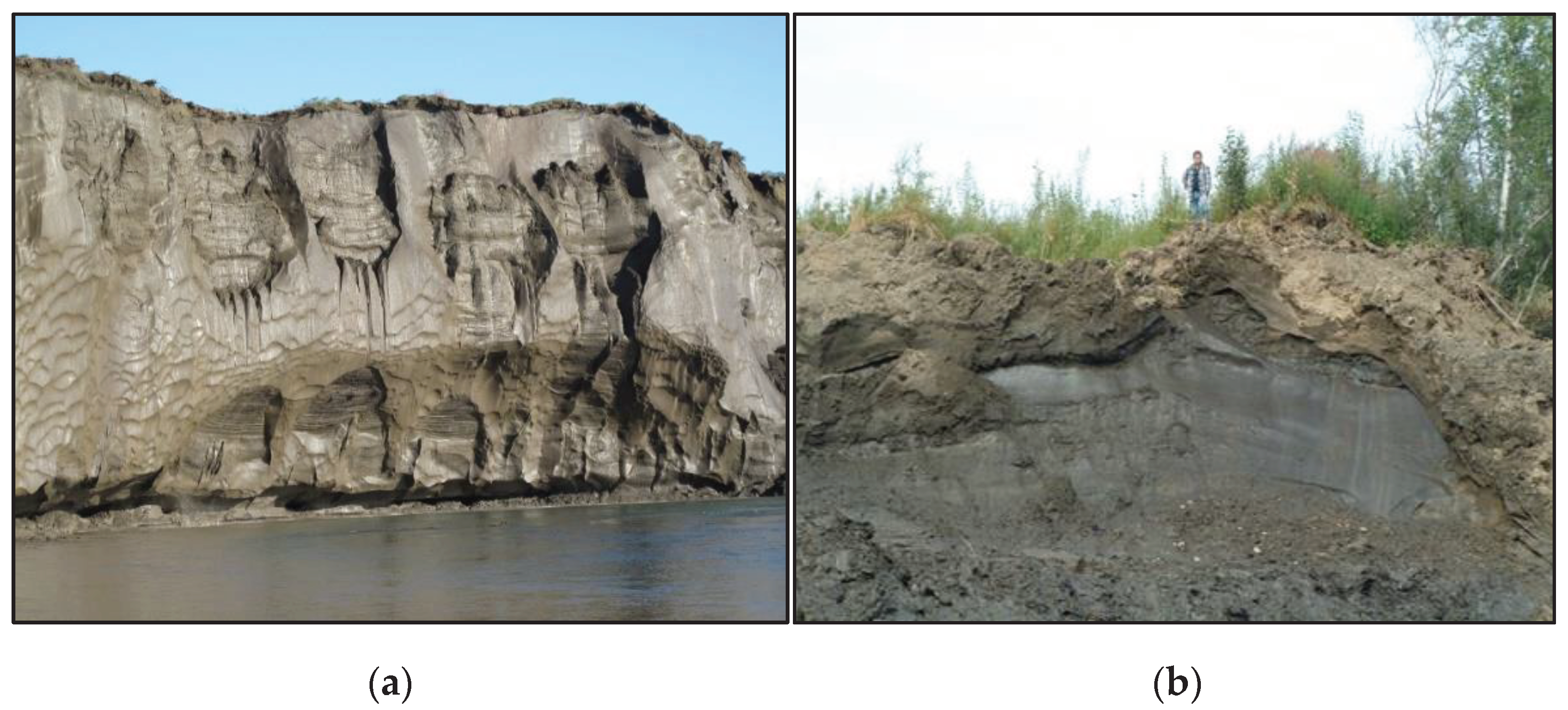
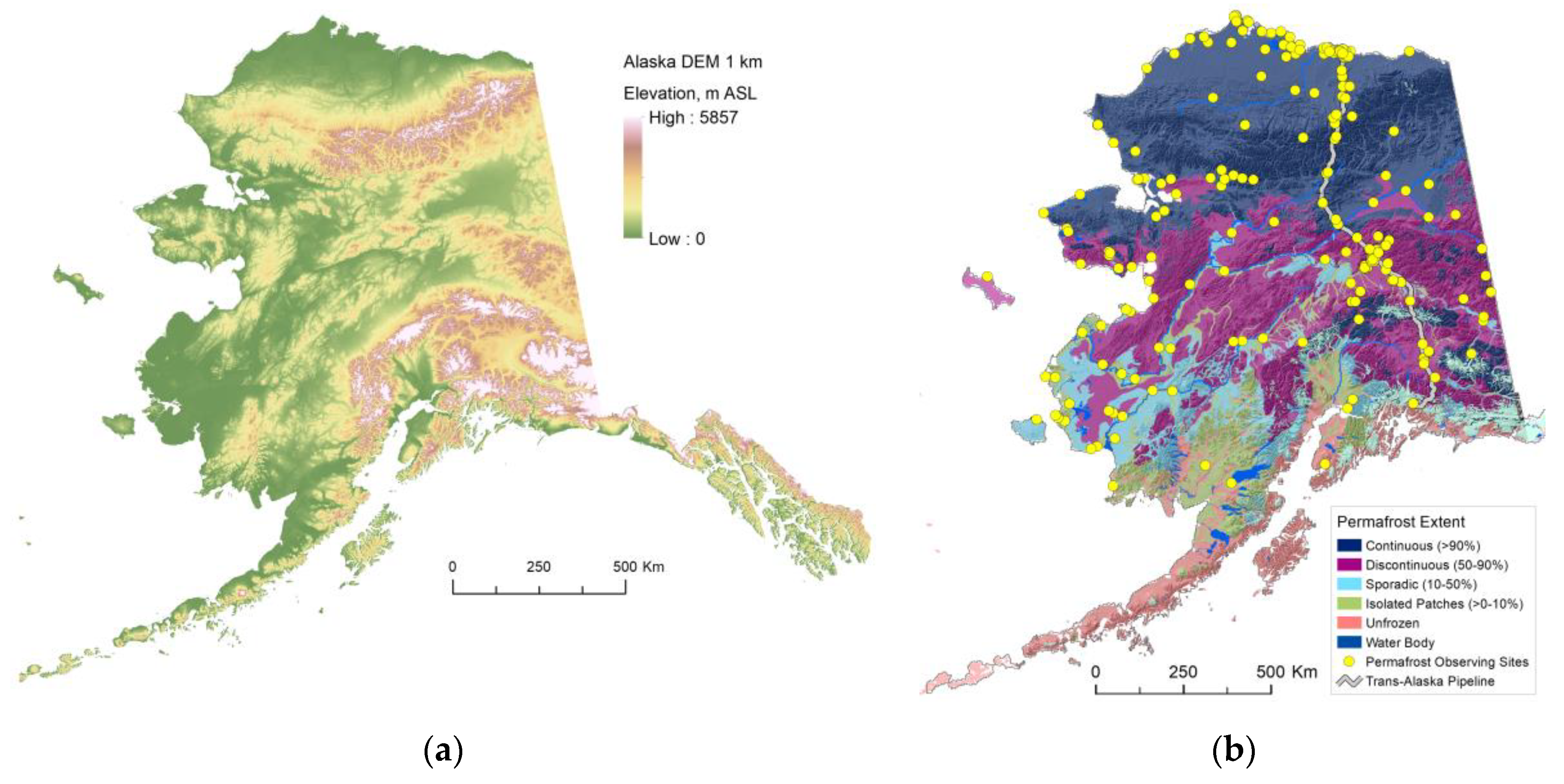
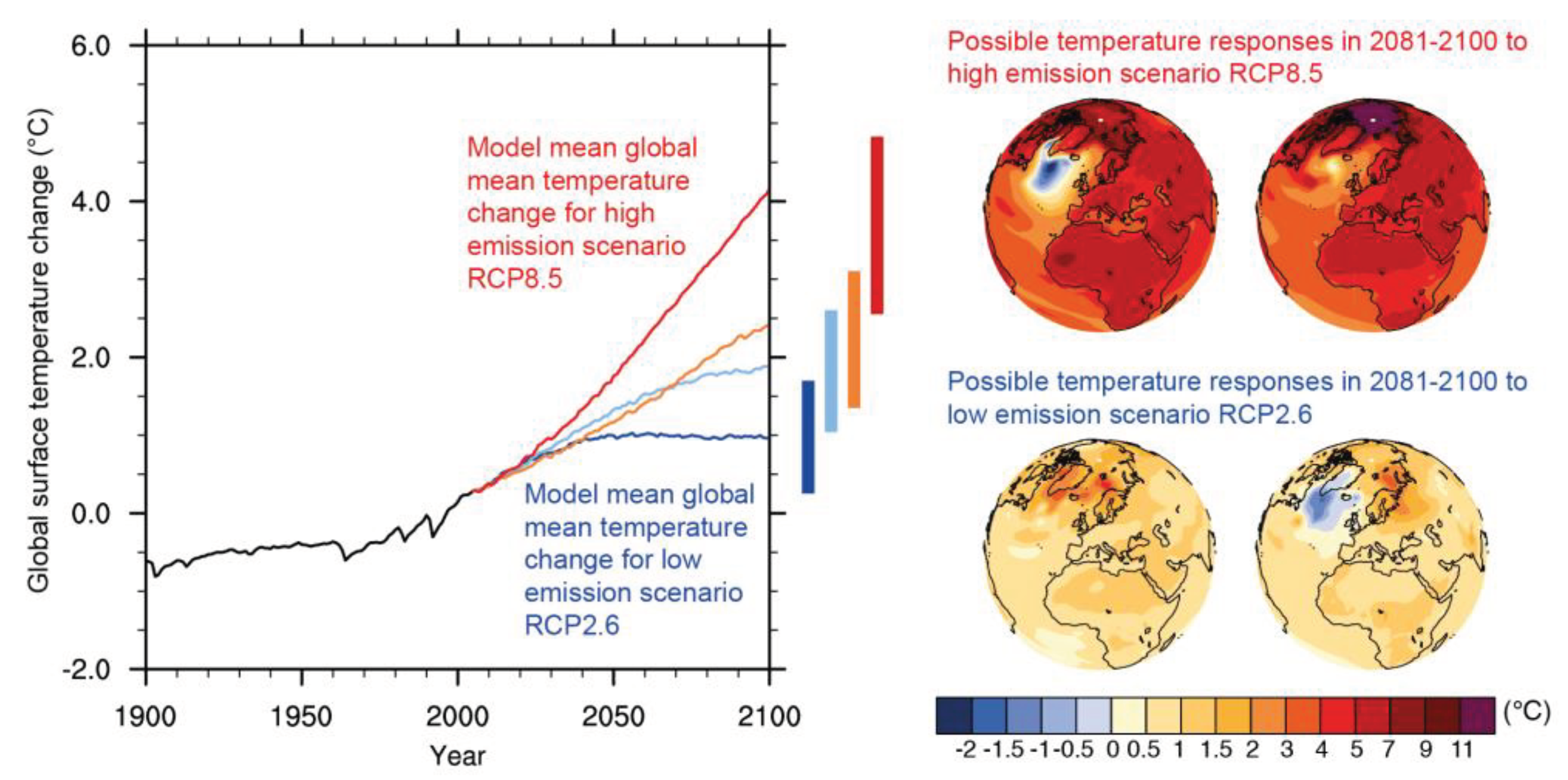
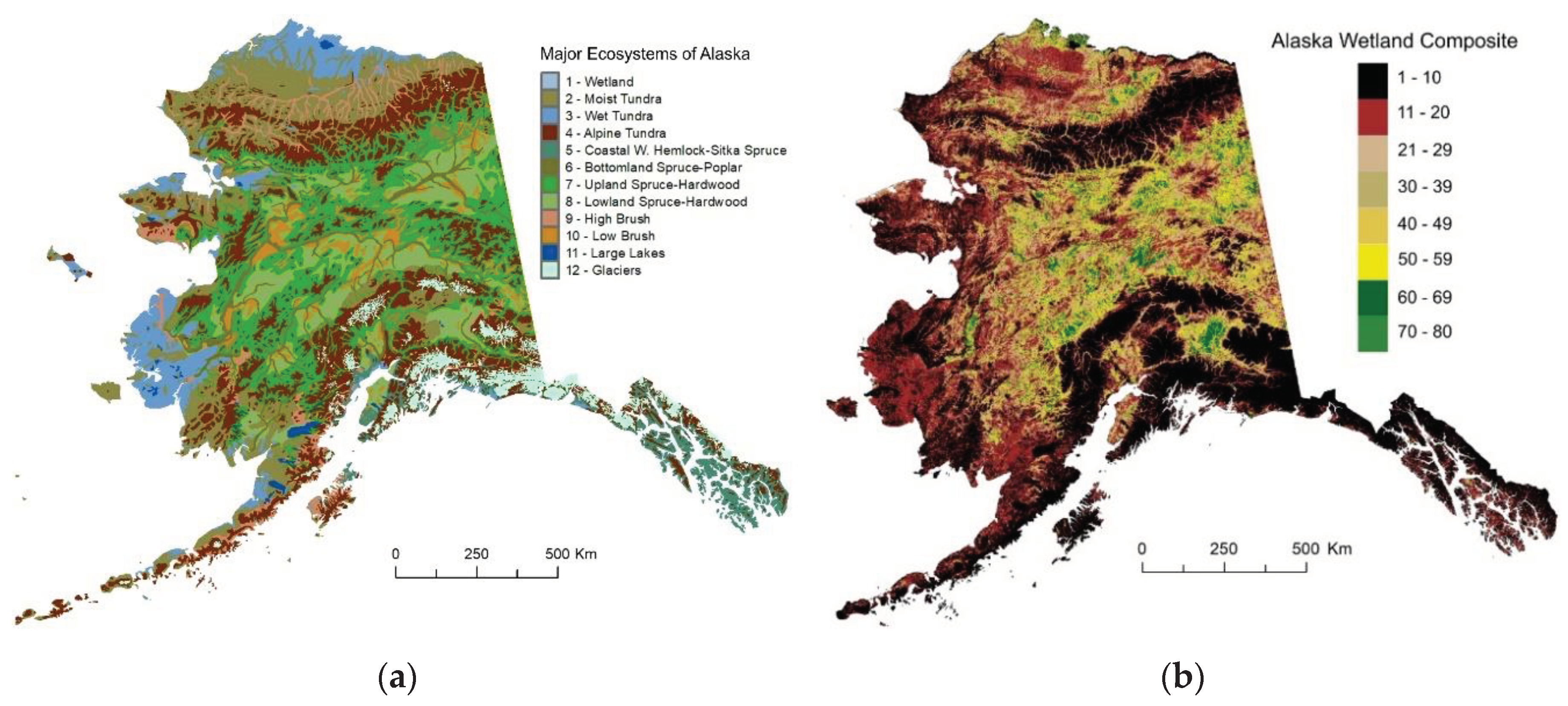
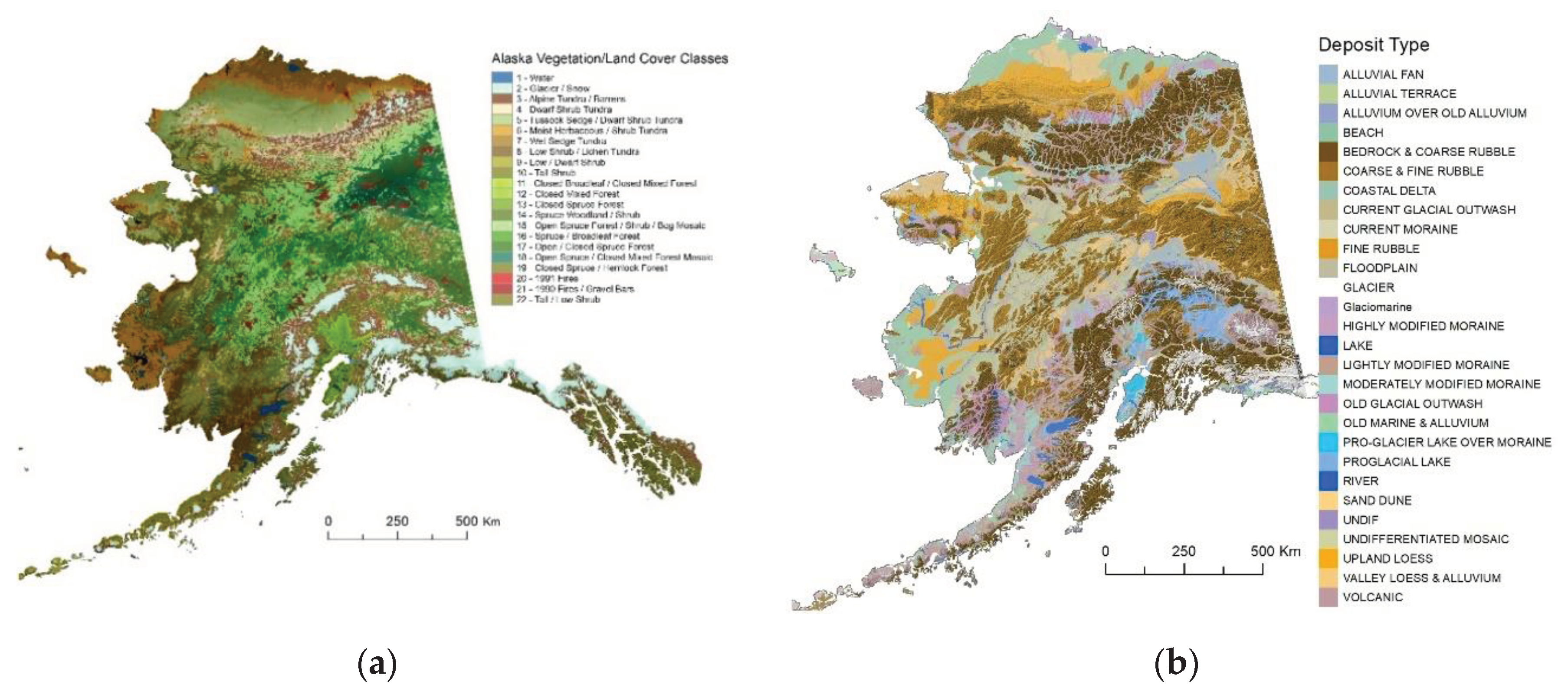
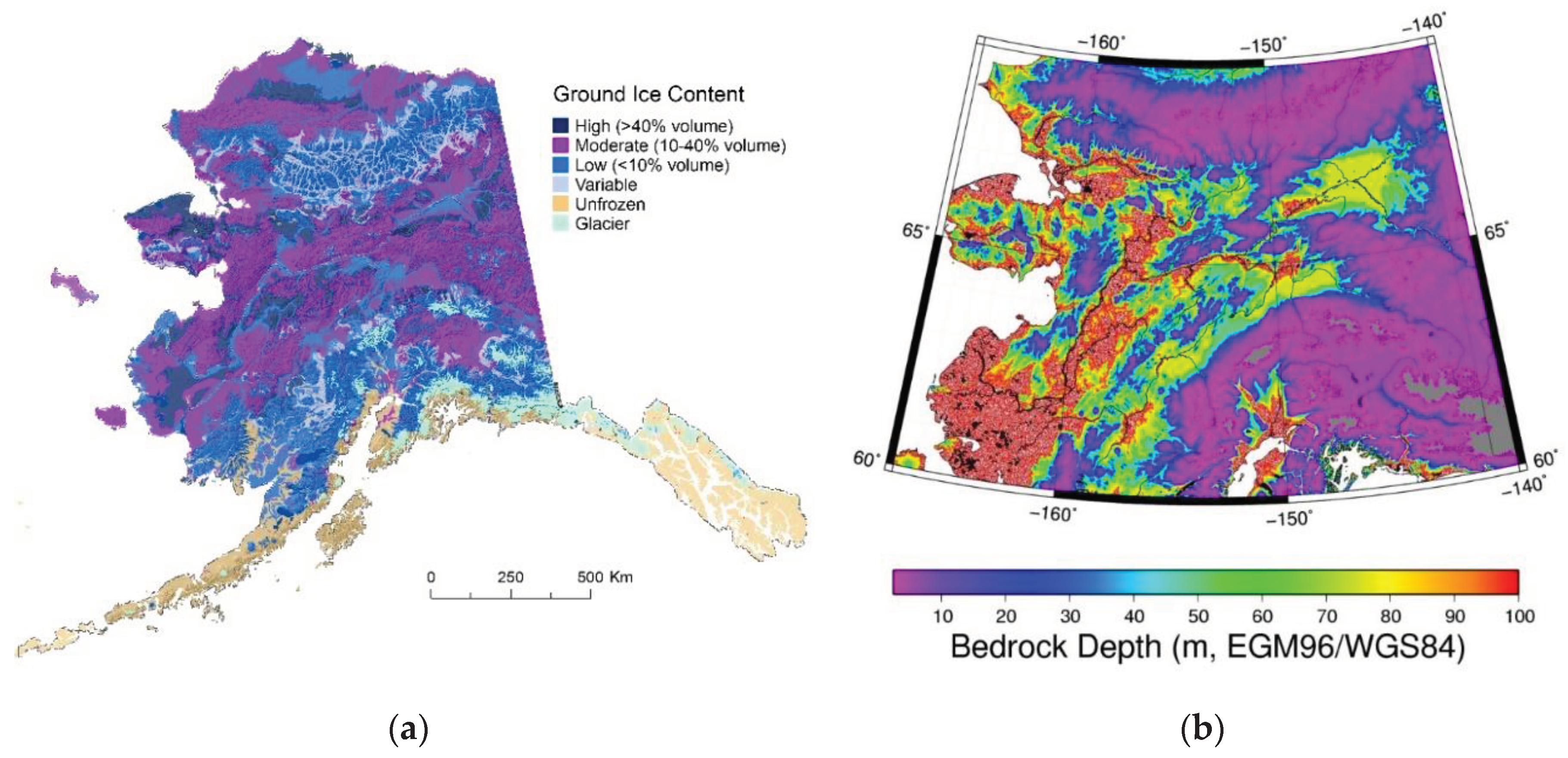
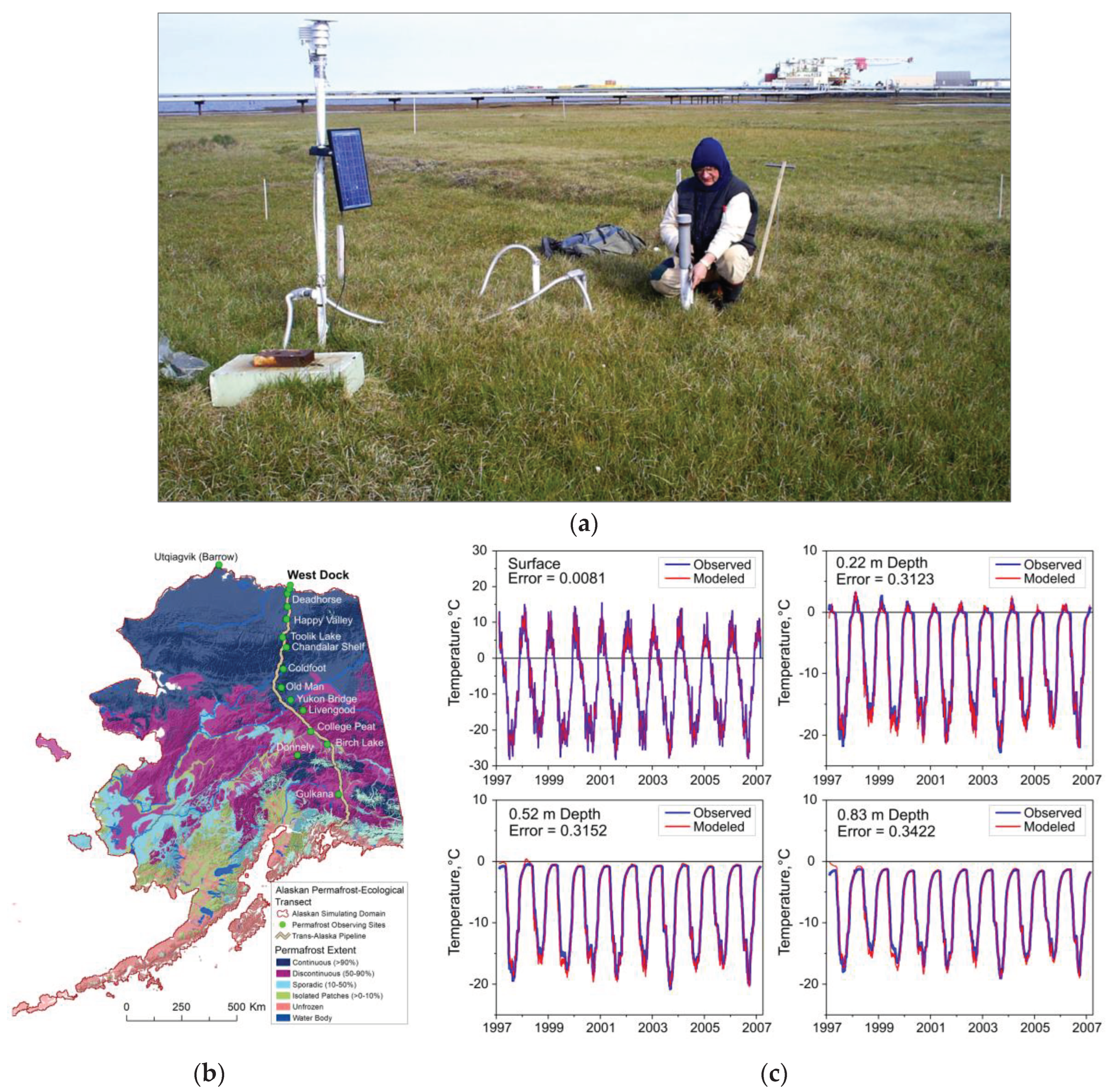
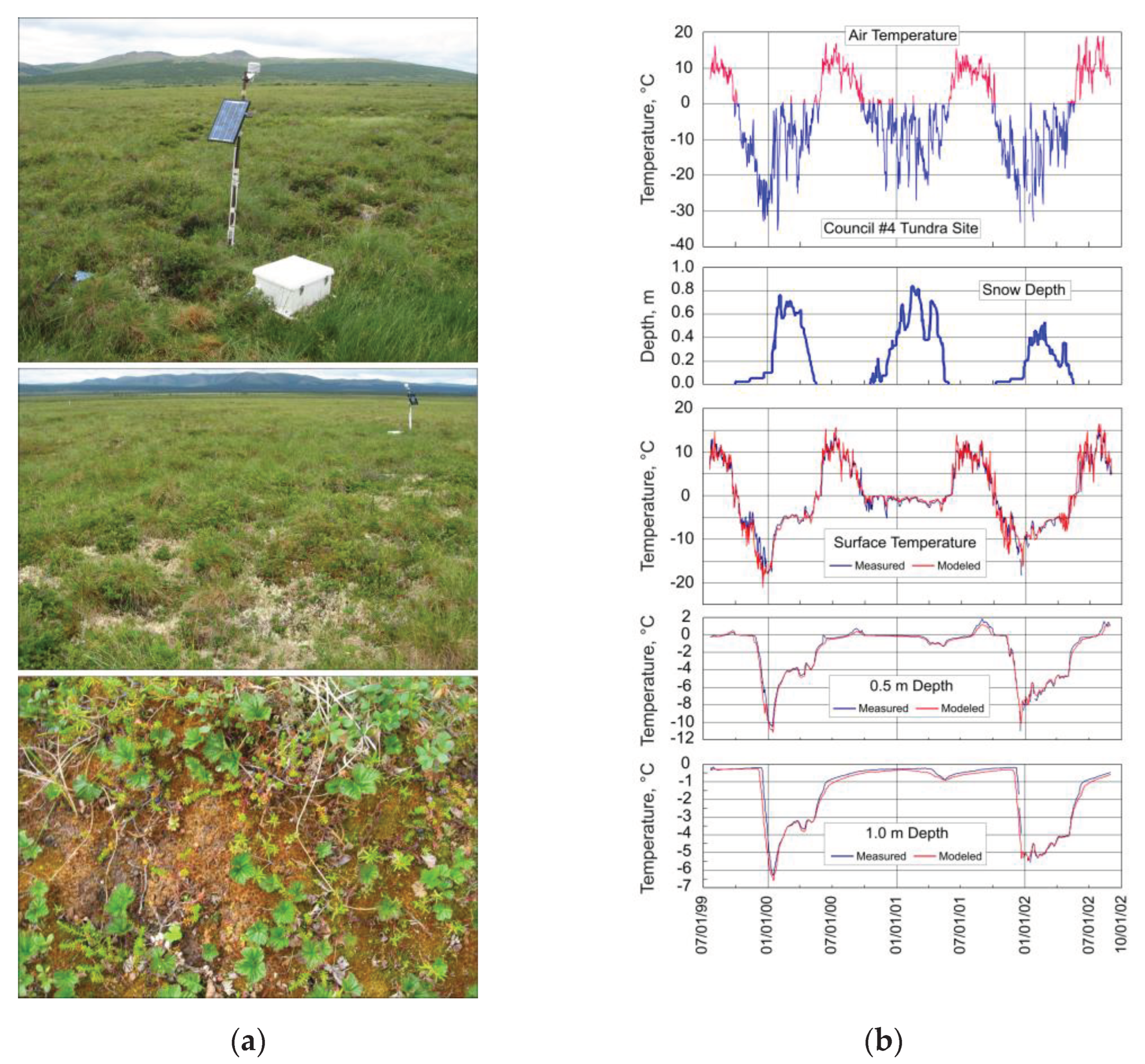
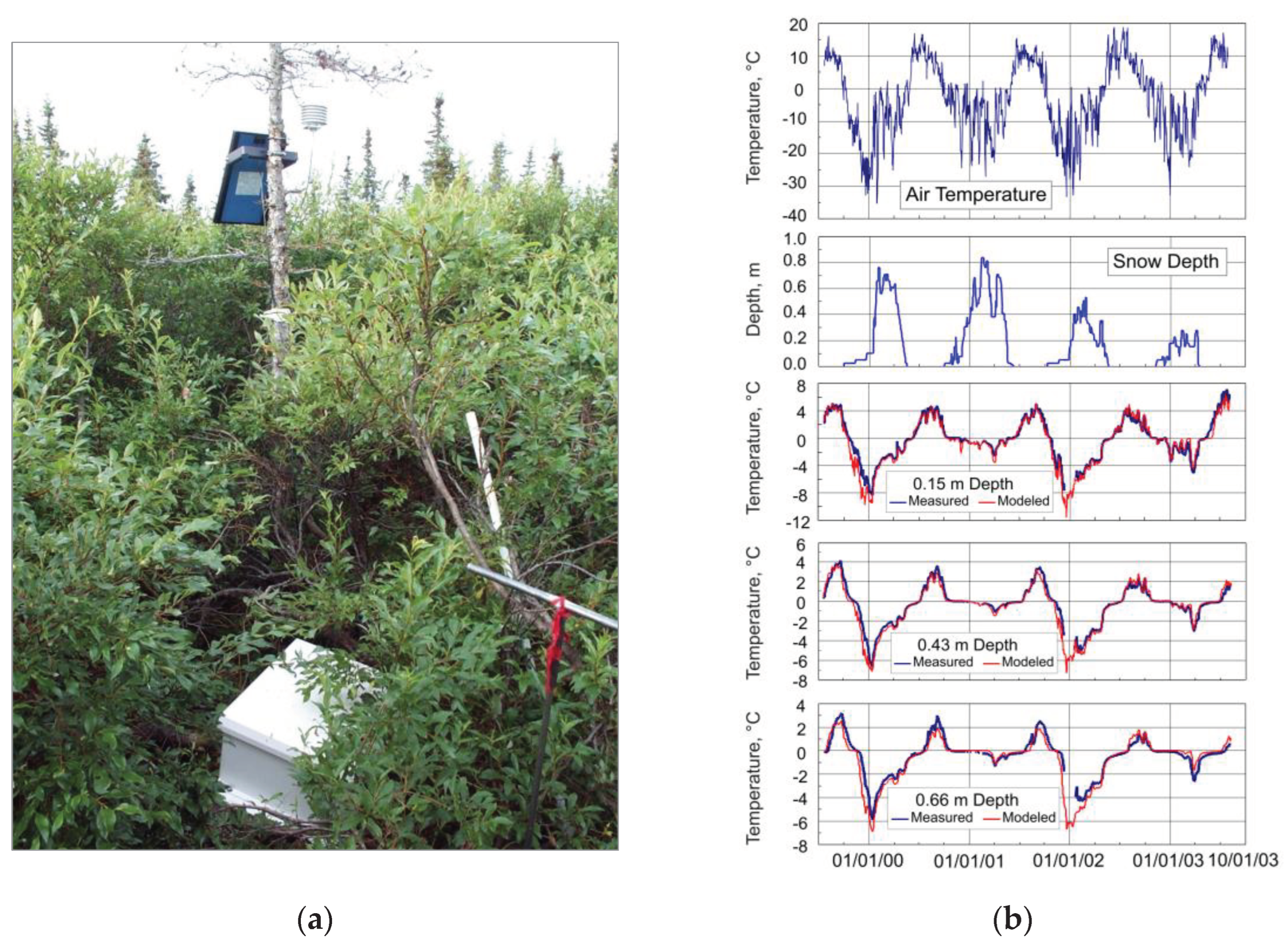
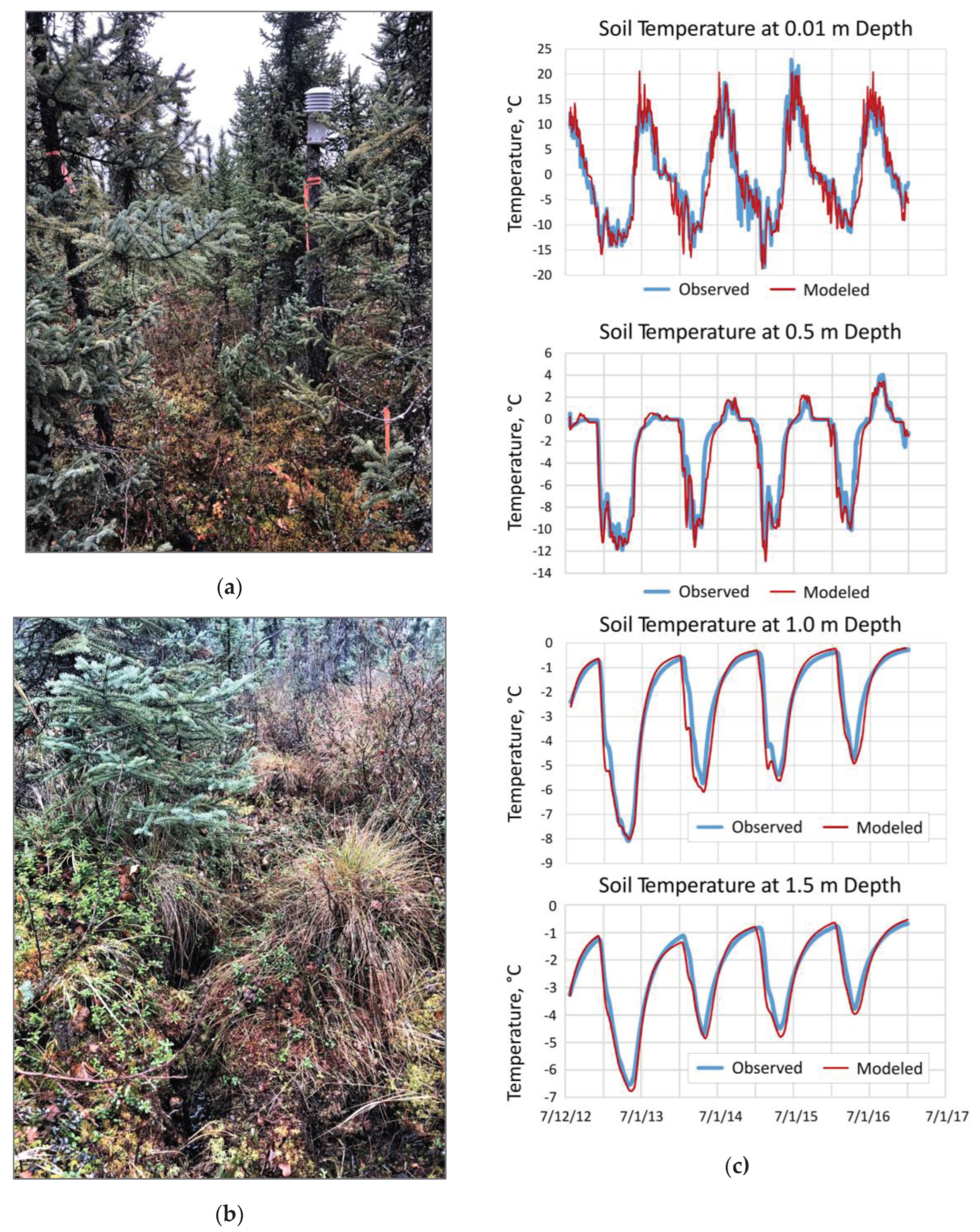
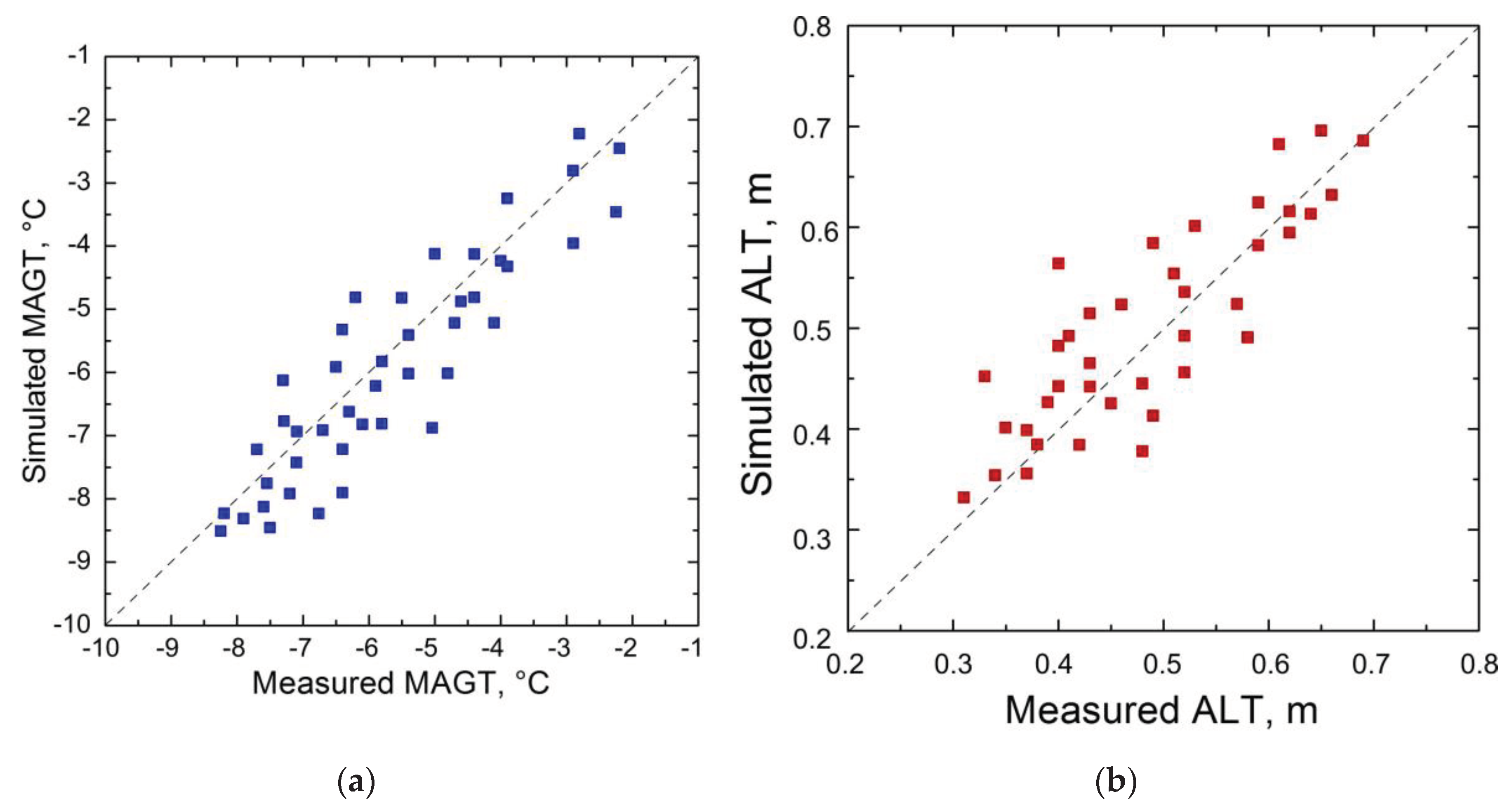
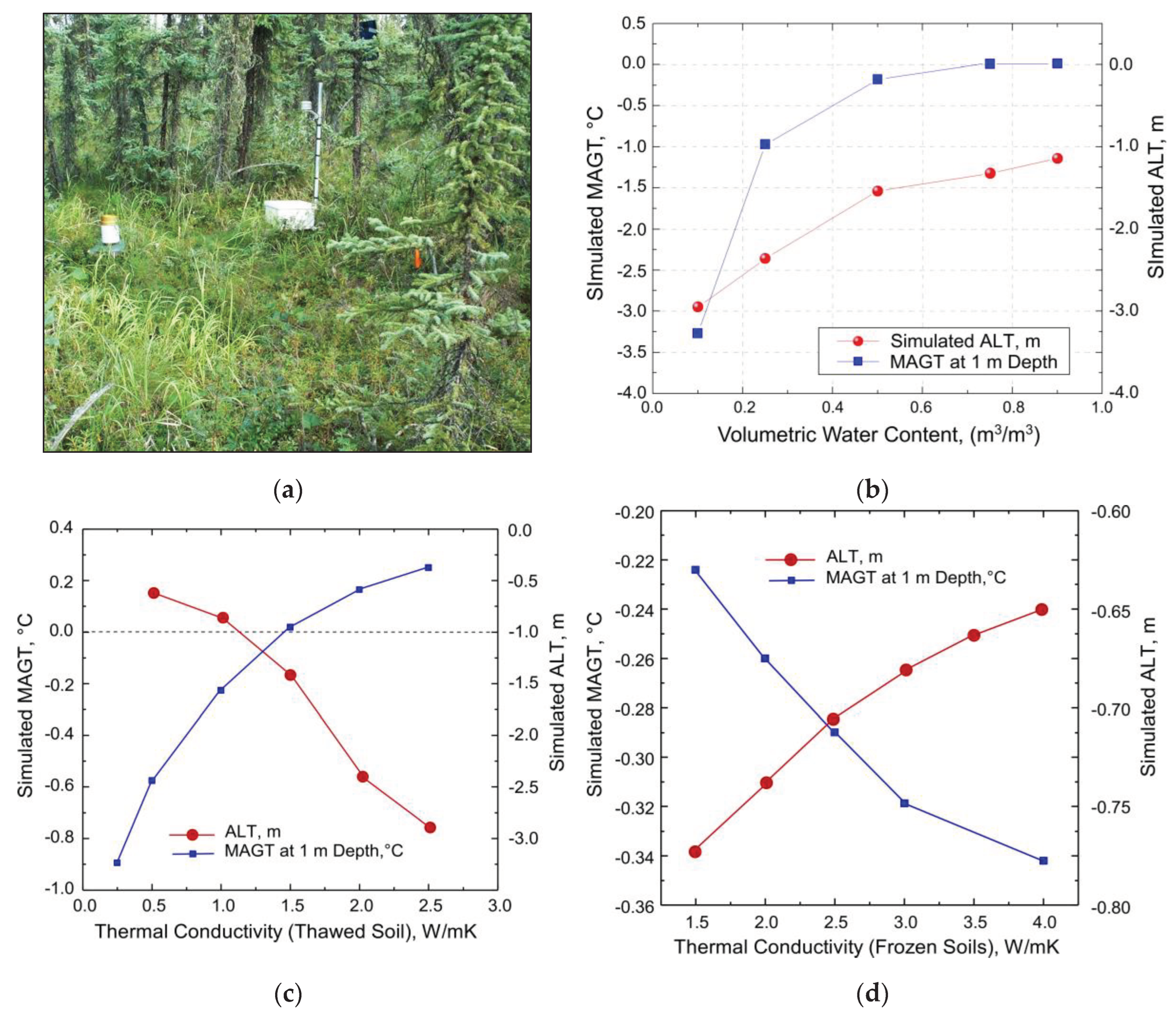
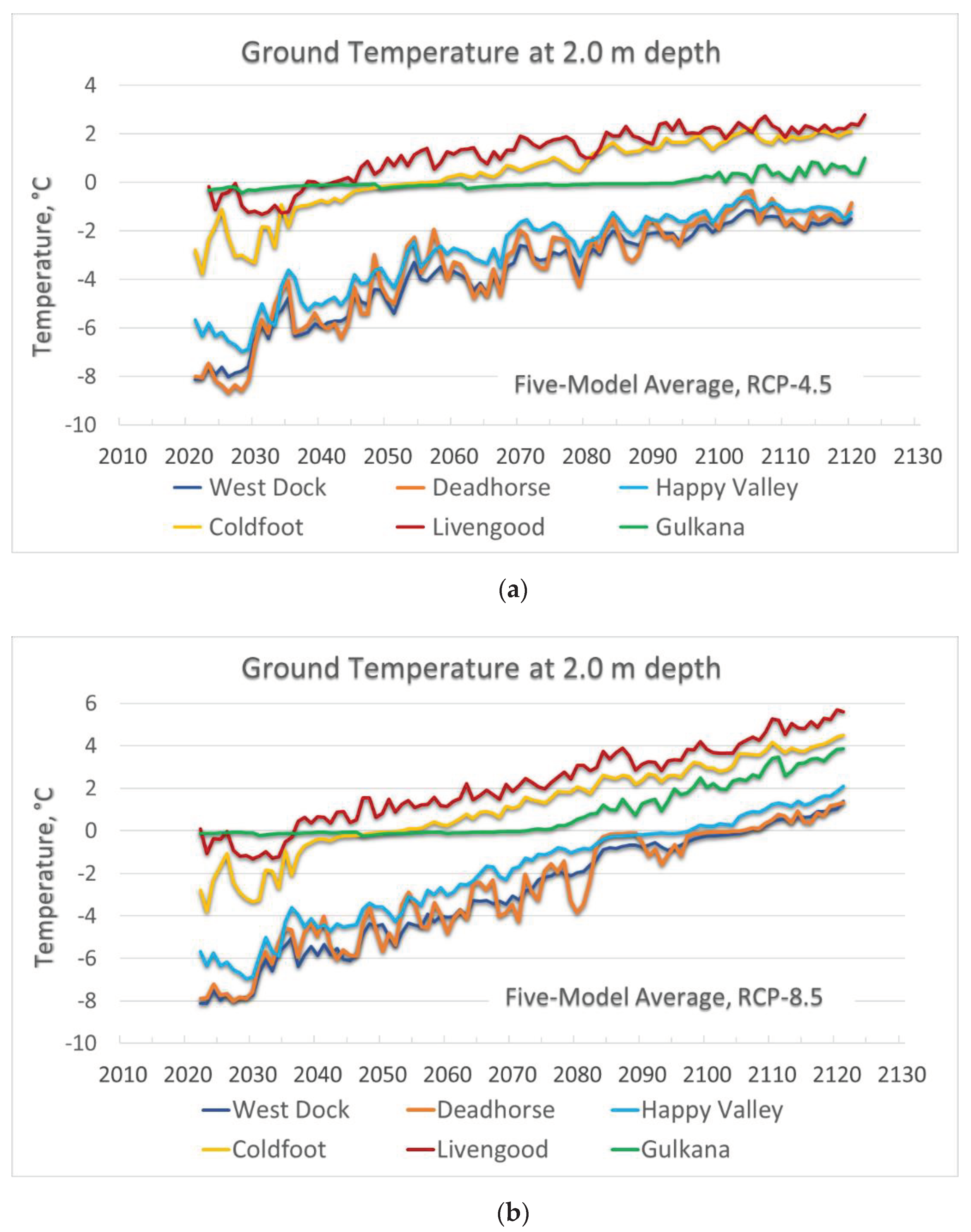
| Heat Capacity | Thermal Conductivity | |||||
| VWC*, | Thawed, | Frozen, | Thawed, | Frozen, | Depth, m | Layer matter (description) |
| m3 m-3 | J m-3 K-1 | J m-3 K-1 | W m-1 K-1 | W m-1 K-1 | ||
| Sub-polar or polar grassland-lichen-moss | ||||||
| 0.694 | 1.72d6 | 1.21d6 | 0.242 | 0.895 | 0.0-0.12 | moss |
| 0.696 | 1.93d6 | 1.51d6 | 0.452 | 1.032 | 0.12-0.22 | peat 1 (shallow organic, fibrous) |
| 0.583 | 2.02d6 | 1.65d6 | 0.524 | 1.056 | 0.22-0.68 | peat 2 (deep organic, amorphous) |
| 0.456 | 2.54d6 | 1.72d6 | 1.023 | 1.516 | 0.68-5.6 | mineral 1, silt |
| 0.442 | 2.93d6 | 2.23d6 | 1.216 | 1.645 | 5.6-8.8 | mineral 2, silty loam |
| 0.426 | 3.43d6 | 2.83d6 | 1.424 | 1.849 | 8.8-48.5 | mix of silt, gravel, sand, debris |
| 0.384 | 3.63d6 | 3.12d6 | 1.832 | 2.214 | 48.5-58.0 | gravel, coarse sand, debris |
| 0.071 | 3.85d6 | 3.46d6 | 2.502 | 2.589 | 58.0-100.0 | Bedrock |
| Bare mineral soil | ||||||
| 0.482 | 2.51d6 | 1.71d6 | 1.234 | 2.123 | 0.0-3.2 | mineral 1, silt |
| 0.356 | 1.83d6 | 1.63d6 | 2.134 | 2.821 | 3.2-18.5 | mineral 2, silt |
| 0.082 | 1.92d6 | 1.66d6 | 2.232 | 2.865 | 18.5-100.0 | Bedrock |
| Deciduous forest | ||||||
| 0.384 | 1.8d6 | 1.6d6 | 0.121 | 0.123 | 0.0-0.09 | Litter |
| 0.484 | 1.8d6 | 1.6d6 | 0.152 | 0.286 | 0.09-0.16 | peat 1 (shallow organic, fibrous) |
| 0.532 | 1.9d6 | 1.7d6 | 0.265 | 0.384 | 0.16-0.21 | peat 2 (deep organic, amorphous) |
| 0.416 | 2.2d6 | 2.1d6 | 1.101 | 1.542 | 0.21-0.6 | mineral 1, silt |
| 0.405 | 2.5d6 | 1.8d6 | 1.213 | 1.854 | 0.6-3.1 | mineral 2, silty loam |
| 0.341 | 1.8d6 | 1.6d6 | 2.215 | 2.865 | 3.1-63.5 | mix of silt, gravel, sand, debris |
| 0.076 | 1.8d6 | 1.6d6 | 2.321 | 2.845 | 63.5-100.0 | Bedrock |
| Mixed Forest | ||||||
| 0.384 | 1.8d6 | 1.6d6 | 0.094 | 0.134 | 0.0-0.03 | Litter, moss |
| 0.556 | 1.8d6 | 1.6d6 | 0.134 | 0.254 | 0.03-0.11 | peat 1 (shallow organic, fibrous) |
| 0.587 | 1.9d6 | 1.7d6 | 0.225 | 0.365 | 0.11-0.27 | peat 2 (deep organic, amorphous) |
| 0.412 | 2.2d6 | 2.1d6 | 1.132 | 1.543 | 0.27-0.97 | mineral 1, silt |
| 0.375 | 2.5d6 | 1.8d6 | 1.143 | 1.842 | 0.97-42.2 | mineral 2, silt loam |
| 0.313 | 1.8d6 | 1.6d6 | 2.245 | 2.843 | 42.2-52.5 | mix of silt, gravel, sand, debris |
| 0.067 | 1.8d6 | 1.6d6 | 2.236 | 2.837 | 52.5-100.0 | Bedrock |
| Herb Fen | ||||||
| 0.354 | 2.8d6 | 2.1d6 | 0.324 | 0.425 | 0.0-0.03 | Grass |
| 0.562 | 2.3d6 | 1.9d6 | 0.445 | 0.684 | 0.45-0.95 | peat 1 (shallow organic, fibrous) |
| 0.762 | 2.9d6 | 1.9d6 | 0.523 | 1.124 | 0.95-2.65 | peat 2 (deep organic, amorphous) |
| 0.478 | 2.2d6 | 1.8d6 | 1.234 | 2.031 | 2.65-3.2 | mineral 1, silt |
| 0.453 | 2.2d6 | 1.8d6 | 1.243 | 1.925 | 3.2-45.0 | mineral 2, silty loam |
| 0.332 | 1.8d6 | 1.6d6 | 2.213 | 2.845 | 45.0-59.5 | mix of silt, gravel, sand, debris |
| 0.062 | 1.8d6 | 1.6d6 | 2.234 | 2.856 | 59.5-100.0 | Bedrock |
| Shrub | ||||||
| 0.284 | 1.8d6 | 1.6d6 | 0.124 | 0.224 | 0.0-0.05 | Grass |
| 0.593 | 2.5d6 | 1.9d6 | 0.321 | 0.663 | 0.05-0.15 | peat 1 (shallow organic, fibrous) |
| 0.562 | 1.9d6 | 1.7d6 | 0.534 | 1.012 | 0.15-0.27 | peat 2 (deep organic, amorphous) |
| 0.456 | 2.2d6 | 2.1d6 | 1.032 | 2.132 | 0.15-0.65 | mineral 1, silt |
| 0.384 | 2.2d6 | 1.8d6 | 1.043 | 1.945 | 0.65-48.6 | mineral 2, silt loam |
| 0.273 | 1.8d6 | 1.6d6 | 2.232 | 2.845 | 48.6-67.2 | mix of silt, gravel, sand, debris |
| 0.079 | 1.8d7 | 1.6d7 | 2.243 | 2.854 | 67.2-100.0 | Bedrock |
| Sphagnum Bog | ||||||
| 0.345 | 2.4d6 | 1.9d6 | 0.245 | 0.384 | 0-0.02 | Lichen |
| 0.512 | 2.5d6 | 1.9d6 | 0.446 | 0.782 | 0.02-0.12 | Moss |
| 0.624 | 2.45d6 | 1.85d6 | 0.412 | 0.865 | 0.12-0.55 | peat 1 (shallow organic, fibrous) |
| 0.742 | 2.9d6 | 1.9d6 | 0.523 | 1.132 | 0.55-1.1 | peat 2 (deep organic, amorphous) |
| 0.425 | 2.2d6 | 1.8d6 | 1.254 | 2.032 | 1.1-2.65 | mineral 1, silt |
| 0.407 | 2.2d6 | 1.8d6 | 1.234 | 1.954 | 2.65-48.2 | mineral 2, silt loam |
| 0.285 | 1.8d6 | 1.6d6 | 2.254 | 2.846 | 48.2-55.5 | mix of silt, gravel, sand, debris |
| 0.072 | 1.8d7 | 1.6d7 | 2.243 | 2.854 | 55.5-100.0 | Bedrock |
| Tussock Tundra | ||||||
| 0.386 | 1.8d6 | 1.6d6 | 0.224 | 0.384 | 0.0-0.03 | Grass, moss |
| 0.545 | 2.5d6 | 1.9d6 | 0.344 | 0.564 | 0.03-0.32 | peat 1 (shallow organic, fibrous) |
| 0.632 | 1.9d6 | 1.7d6 | 0.456 | 0.954 | 0.32-0.52 | peat 2 (deep organic, amorphous) |
| 0.554 | 2.2d6 | 2.1d6 | 0.932 | 2.132 | 0.52-0.68 | peat 3 (deep organic, amorphous) |
| 0.462 | 2.2d6 | 1.8d6 | 1.045 | 2.156 | 0.62-3.55 | mineral 1, silt |
| 0.354 | 1.8d6 | 1.6d6 | 2.234 | 2.658 | 3.55-65.5 | mineral 2, silt loam |
| 0.093 | 1.8d7 | 1.6d7 | 2.654 | 2.865 | 65.5-100.0 | Bedrock |
| White Spruce | ||||||
| 0.545 | 1.8d6 | 1.6d6 | 0.084 | 0.134 | 0.0-0.06 | Moss |
| 0.586 | 1.9d6 | 1.7d6 | 0.125 | 0.226 | 0.06-0.12 | peat 1 (shallow organic, fibrous) |
| 0.565 | 1.9d6 | 1.7d6 | 0.267 | 0.456 | 0.12-0.3 | peat 2 (deep organic, amorphous) |
| 0.447 | 2.2d6 | 2.1d6 | 1.268 | 1.547 | 0.3-0.85 | mineral 1, silt |
| 0.448 | 2.5d6 | 1.8d6 | 1.278 | 1.952 | 0.85-25.5 | mineral 2, silt loam |
| 0.234 | 1.8d6 | 1.6d6 | 2.245 | 2.687 | 25.5-55.6 | mix of silt, gravel, sand, debris |
| 0.081 | 1.8d7 | 1.6d7 | 2.654 | 2.875 | 55.6-100.0 | Bedrock |
| Willow | ||||||
| 0.336 | 1.8d6 | 1.6d6 | 0.146 | 0.287 | 0.0-0.05 | Grass |
| 0.524 | 1.8d6 | 1.6d6 | 0.245 | 0.489 | 0.05-0.22 | peat 1 (shallow organic, fibrous) |
| 0.656 | 1.9d6 | 1.7d6 | 0.368 | 0.765 | 0.22-0.35 | peat 2 (deep organic, amorphous) |
| 0.528 | 2.2d6 | 2.1d6 | 1.157 | 2.213 | 0.35-1.3 | mineral 1, silt |
| 0.512 | 2.5d6 | 1.8d6 | 1.065 | 1.965 | 1.3-3.5 | mineral 2, silt loam |
| 0.285 | 1.8d6 | 1.6d6 | 2.234 | 2.845 | 3.5-54.5 | mix of silt, gravel, sand, debris |
| 0.074 | 1.8d7 | 1.6d7 | 2.543 | 2.985 | 54.5-100.0 | Bedrock |
Disclaimer/Publisher’s Note: The statements, opinions and data contained in all publications are solely those of the individual author(s) and contributor(s) and not of MDPI and/or the editor(s). MDPI and/or the editor(s) disclaim responsibility for any injury to people or property resulting from any ideas, methods, instructions or products referred to in the content. |
© 2024 by the authors. Licensee MDPI, Basel, Switzerland. This article is an open access article distributed under the terms and conditions of the Creative Commons Attribution (CC BY) license (http://creativecommons.org/licenses/by/4.0/).





